How To Write Scope and Delimitation of a Research Paper (With Examples)

An effective research paper or thesis has a well-written Scope and Delimitation. This portion specifies your study’s coverage and boundaries.
Not yet sure about how to write your research’s Scope and Delimitation? Fret not, as we’ll guide you through the entire writing process through this article.
Related: How To Write Significance of the Study (With Examples)

Table of Contents
What is the scope and delimitation of a research paper.

The “Scope and Delimitation” section states the concepts and variables your study covered. It tells readers which things you have included and excluded in your analysis.
This portion tells two things: 1
- The study’s “Scope” – concepts and variables you have explored in your research and;
- The study’s “Delimitation” – the “boundaries” of your study’s scope. It sets apart the things included in your analysis from those excluded.
For example, your scope might be the effectiveness of plant leaves in lowering blood sugar levels. You can “delimit” your study only to the effect of gabi leaves on the blood glucose of Swiss mice.
Where Should I Put the Scope and Delimitation?
This portion is in Chapter 1, usually after the “Background of the Study.”
Why Should I Write the Scope and Delimitation of My Research Paper?
There’s a lot to discover in a research paper or thesis. However, your resources and time dedicated to it are scarce. Thus, given these constraints, you have to narrow down your study. You do this in the Scope and Delimitation.
Suppose you’re studying the correlation between the quantity of organic fertilizer and plant growth . Experimenting with several types of plants is impossible because of several limitations. So, you’ve decided to use one plant type only.
Informing your readers about this decision is a must. So, you have to state it in your Scope and Delimitation. It also acts as a “disclaimer” that your results are inapplicable to the entire plant kingdom.
What Is the Difference Between Delimitation and Limitation?

People often use the terms “Delimitation” and “Limitation” interchangeably. However, these words differ 2 .
Delimitation refers to factors you set to limit your analysis. It delineates those that are included in your research and those that are excluded. Remember, delimitations are within your control.
Meanwhile, limitations are factors beyond your control that may affect your research’s results. You can think of limitations as the “weaknesses” of your study.
Let’s go back to our previous example. Due to some constraints, you’ve only decided to examine one plant type: dandelions. This is an example of a delimitation since it limits your analysis to dandelions only and not other plant types. Note that the number of plant types used is within your control.
Meanwhile, your study cannot state that a higher quantity of organic fertilizer is the sole reason for plant growth. That’s because your research’s focus is only on correlation. Since this is already beyond your control, then this is a limitation.
How To Write Scope and Delimitation: Step-by-Step Guide
To write your research’s Scope and Delimitation section, follow these steps:
1. Review Your Study’s Objectives and Problem Statement

Your study’s coverage relies on its objectives. Thus, you can only write this section if you know what you’re researching. Furthermore, ensure that you understand the problems you ought to answer.
Once you understand the abovementioned things, you may start writing your study’s Scope and Delimitation.
2. State the Key Information To Explain Your Study’s Coverage and Boundaries

a. The Main Objective of the Research
This refers to the concept that you’re focusing on in your research. Some examples are the following:
- level of awareness or satisfaction of a particular group of people
- correlation between two variables
- effectiveness of a new product
- comparison between two methods/approaches
- lived experiences of several individuals
It’s helpful to consult your study’s Objectives or Statement of the Problem section to determine your research’s primary goal.
b. Independent and Dependent Variables Included
Your study’s independent variable is the variable that you manipulate. Meanwhile, the dependent variable is the variable whose result depends upon the independent variable. Both of these variables must be clear and specific when indicated.
Suppose you study the relationship between social media usage and students’ language skills. These are the possible variables for the study:
- Independent Variable: Number of hours per day spent on using Facebook
- Dependent Variable: Grade 10 students’ scores in Quarterly Examination in English.
Note how specific the variables stated above are. For the independent variable, we narrow it down to Facebook only. Since there are many ways to assess “language skills,” we zero in on the students’ English exam scores as our dependent variable.
c. Subject of the Study
This refers to your study’s respondents or participants.
In our previous example, the research participants are Grade 10 students. However, there are a lot of Grade 10 students in the Philippines. Thus, we have to select from a specific school only—for instance, Grade 10 students from a national high school in Manila.
d. Timeframe and Location of the Study
Specify the month(s), quarter(s), or year(s) as the duration of your study. Also, indicate where you will gather the data required for your research.
e. Brief Description of the Study’s Research Design and Methodology
You may also include whether your research is quantitative or qualitative, the sampling method (cluster, stratified, purposive) applied, and how you conducted the experiment.
Using our previous example, the Grade 10 students can be selected using stratified sampling. Afterward, the researchers may obtain their English quarterly exam scores from their respective teachers. You can add these things to your study’s Scope and Delimitation.
3. Indicate Which Variables or Factors Are Not Covered by Your Research

Although you’ve already set your study’s coverage and boundaries in Step 2, you may also explicitly mention things you’ve excluded from your research.
Returning to our previous example, you can state that your assessment will not include the vocabulary and oral aspects of the English proficiency skill.
Examples of Scope and Delimitation of a Research Paper
1. scope and delimitation examples for quantitative research.

a. Example 1
Research Title
A Study on the Relationship of the Extent of Facebook Usage on the English Proficiency Level of Grade 10 Students of Matagumpay High School
Scope and Delimitation
(Main Objective)
This study assessed the correlation between the respondents’ duration of Facebook usage and their English proficiency level.
(Variables used)
The researchers used the number of hours per day of using Facebook and the activities usually performed on the platform to assess the respondents’ extent of Facebook usage. Meanwhile, the respondents’ English proficiency level is limited to their quarterly English exam scores.
(Subject of the study)
A sample of fifty (50) Grade 10 students of Matagumpay High School served as the study’s respondents.
(Timeframe and location)
This study was conducted during the Second Semester of the School Year 2018 – 2019 on the premises of Matagumpay High School in Metro Manila.
(Methodology)
The respondents are selected by performing stratified random sampling to ensure that there will be ten respondents from five Grade 10 classes of the school mentioned above. The researchers administered a 20-item questionnaire to assess the extent of Facebook usage of the selected respondents. Meanwhile, the data for the respondents’ quarterly exam scores were acquired from their English teachers. The collected data are handled with the utmost confidentiality. Spearman’s Rank Order Correlation was applied to quantitatively assess the correlation between the variables.
(Exclusions)
This study didn’t assess other aspects of the respondents’ English proficiency, such as English vocabulary and oral skills.
Note: The words inside the parentheses in the example above are guides only. They are not included in the actual text.
b. Example 2
Level of Satisfaction of Grade 11 Students on the Implementation of the Online Learning Setup of Matagumpay High School for SY 2020 – 2021
This study aims to identify students’ satisfaction levels with implementing online learning setups during the height of the COVID-19 pandemic.
Students’ satisfaction was assessed according to teachers’ pedagogy, school policies, and learning materials used in the online learning setup. The respondents included sixty (60) Grade 11 students of Matagumpay High School who were randomly picked. The researchers conducted the study from October 2020 to February 2021.
Online platforms such as email and social media applications were used to reach the respondents. The researchers administered a 15-item online questionnaire to measure the respondents’ satisfaction levels. Each response was assessed using a Likert Scale to provide a descriptive interpretation of their answers. A weighted mean was applied to determine the respondents’ general satisfaction.
This study did not cover other factors related to the online learning setup, such as the learning platform used, the schedule of synchronous learning, and channels for information dissemination.
2. Scope and Delimitation Examples for Qualitative Research

Lived Experiences of Public Utility Vehicle (PUV) Drivers of Antipolo City Amidst the Continuous June 2022 Oil Price Hikes
This research focused on the presentation and discussion of the lived experiences of PUV drivers during the constant oil price hike in June 2022.
The respondents involved are five (5) jeepney drivers from Antipolo City who agreed to be interviewed. The researchers assessed their experiences in terms of the following: (1) daily net income; (2) duration and extent of working; (3) alternative employment opportunity considerations; and (4) mental and emotional status. The respondents were interviewed daily at their stations on June 6 – 10, 2022.
In-depth one-on-one interviews were used for data collection. Afterward, the respondents’ first-hand experiences were drafted and annotated with the researchers’ insights.
The researchers excluded some factors in determining the respondents’ experiences, such as physical and health conditions and current family relationship status.
A Study on the Perception of the Residents of Mayamot, Antipolo City on the Political and Socioeconomic Conditions During the Post-EDSA Period (1986 – 1996)
This research aims to discuss the perception of Filipinos regarding the political and socioeconomic economic conditions during the post-EDSA period, specifically during the years 1986 – 1996.
Ten (10) residents of Mayamot, Antipolo City, who belonged to Generation X (currently 40 – 62 years old), were purposively selected as the study’s respondents. The researchers asked them about their perception of the following aspects during the period mentioned above (1) performance of national and local government; (2) bureaucracy and government services; (3) personal economic and financial status; and (4) wage purchasing power.
The researchers conducted face-to-face interviews in the respondents’ residences during the second semester of AY 2018 – 2019. The responses were written and corroborated with the literature on the post-EDSA period.
The following factors were not included in the research analysis: political conflicts and turmoils, the status of the legislative and judicial departments, and other macroeconomic indicators.
Tips and Warnings
1. use the “5ws and 1h” as your guide in understanding your study’s coverage.
- Why did you write your study?
- What variables are included?
- Who are your study’s subject
- Where did you conduct the study?
- When did your study start and end?
- How did you conduct the study?
2. Use key phrases when writing your research’s scope
- This study aims to …
- This study primarily focuses on …
- This study deals with …
- This study will cover …
- This study will be confined…
3. Use key phrases when writing factors beyond your research’s delimitations
- The researcher(s) decided to exclude …
- This study did not cover….
- This study excluded …
- These variables/factors were excluded from the study…
4. Don’t forget to ask for help
Your research adviser can assist you in selecting specific concepts and variables suitable to your study. Make sure to consult him/her regularly.
5. Make it brief
No need to make this section wordy. You’re good to go if you meet the “5Ws and 1Hs”.
Frequently Asked Questions
1. what are scope and delimitation in tagalog.
In a Filipino research ( pananaliksik ), Scope and Delimitation is called “ Saklaw at Delimitasyon”.
Here’s an example of Scope and Delimitation in Filipino:
Pamagat ng Pananaliksik
Epekto Ng Paggamit Ng Mga Digital Learning Tools Sa Pag-Aaral Ng Mga Mag-Aaral Ng Mataas Na Paaralan Ng Matagumpay Sa General Mathematics
Sakop at Delimitasyon ng Pag-aaral
Nakatuon ang pananaliksik na ito sa epekto ng paggamit ng mga digital learning aids sa pag-aaral ng mga mag-aaral.
Ang mga digital learning tools na kinonsidera sa pag-aaral na ito ay Google Classroom, Edmodo, Kahoot, at mga piling bidyo mula YouTube. Samantala, ang epekto sa pag-aaral ng mga mag-aaral ng mga nabanggit na digital learning tools ay natukoy sa pamamagitan ng kanilang (1) mga pananaw hinggil sa benepisyo nito sa kanilang pag-aaral sa General Mathematics at (2) kanilang average grade sa asignaturang ito.
Dalawampu’t-limang (25) mag-aaral mula sa Senior High School ng Mataas na Paaralan ng Matagumpay ang pinili para sa pananaliksik na ito. Sila ay na-interbyu at binigyan ng questionnaire noong Enero 2022 sa nasabing paaralan. Sinuri ang resulta ng pananaliksik sa pamamagitan ng mga instrumentong estadistikal na weighted mean at Analysis of Variance (ANOVA). Hindi saklaw ng pananaliksik na ito ang ibang mga aspeto hinggil sa epekto ng online learning aids sa pag-aaral gaya ng lebel ng pag-unawa sa aralin at kakayahang iugnay ito sa araw-araw na buhay.
2. The Scope and Delimitation should consist of how many paragraphs?
Three or more paragraphs will suffice for your study’s Scope and Delimitation. Here’s our suggestion on what you should write for each paragraph:
Paragraph 1: Introduction (state research objective) Paragraph 2: Coverage and boundaries of the research (you may divide this section into 2-3 paragraphs) Paragraph 3 : Factors excluded from the study
- University of St. La Salle. Unit 3: Lesson 3 Setting the Scope and Limitation of a Qualitative Research [Ebook] (p. 12). Retrieved from https://www.studocu.com/ph/document/university-of-st-la-salle/senior-high-school/final-sg-pr1-11-12-unit-3-lesson-3-setting-the-scope-and-limitation-of-a-qualitative-research/24341582
- Theofanidis, D., & Fountouki, A. (2018). Limitations and Delimitations in the Research Process. Perioperative Nursing (GORNA), 7(3), 155–162. doi: 10.5281/zenodo.2552022
Written by Jewel Kyle Fabula
in Career and Education , Juander How
Jewel Kyle Fabula
Jewel Kyle Fabula is a Bachelor of Science in Economics student at the University of the Philippines Diliman. His passion for learning mathematics developed as he competed in some mathematics competitions during his Junior High School years. He loves cats, playing video games, and listening to music.
Browse all articles written by Jewel Kyle Fabula
Copyright Notice
All materials contained on this site are protected by the Republic of the Philippines copyright law and may not be reproduced, distributed, transmitted, displayed, published, or broadcast without the prior written permission of filipiknow.net or in the case of third party materials, the owner of that content. You may not alter or remove any trademark, copyright, or other notice from copies of the content. Be warned that we have already reported and helped terminate several websites and YouTube channels for blatantly stealing our content. If you wish to use filipiknow.net content for commercial purposes, such as for content syndication, etc., please contact us at legal(at)filipiknow(dot)net
Scope and Delimitations in Research
Delimitations are the boundaries that the researcher sets in a research study, deciding what to include and what to exclude. They help to narrow down the study and make it more manageable and relevant to the research goal.
Updated on October 19, 2022

All scientific research has boundaries, whether or not the authors clearly explain them. Your study's scope and delimitations are the sections where you define the broader parameters and boundaries of your research.
The scope details what your study will explore, such as the target population, extent, or study duration. Delimitations are factors and variables not included in the study.
Scope and delimitations are not methodological shortcomings; they're always under your control. Discussing these is essential because doing so shows that your project is manageable and scientifically sound.
This article covers:
- What's meant by “scope” and “delimitations”
- Why these are integral components of every study
- How and where to actually write about scope and delimitations in your manuscript
- Examples of scope and delimitations from published studies
What is the scope in a research paper?
Simply put, the scope is the domain of your research. It describes the extent to which the research question will be explored in your study.
Articulating your study's scope early on helps you make your research question focused and realistic.
It also helps decide what data you need to collect (and, therefore, what data collection tools you need to design). Getting this right is vital for both academic articles and funding applications.
What are delimitations in a research paper?
Delimitations are those factors or aspects of the research area that you'll exclude from your research. The scope and delimitations of the study are intimately linked.
Essentially, delimitations form a more detailed and narrowed-down formulation of the scope in terms of exclusion. The delimitations explain what was (intentionally) not considered within the given piece of research.
Scope and delimitations examples
Use the following examples provided by our expert PhD editors as a reference when coming up with your own scope and delimitations.
Scope example
Your research question is, “What is the impact of bullying on the mental health of adolescents?” This topic, on its own, doesn't say much about what's being investigated.
The scope, for example, could encompass:
- Variables: “bullying” (dependent variable), “mental health” (independent variable), and ways of defining or measuring them
- Bullying type: Both face-to-face and cyberbullying
- Target population: Adolescents aged 12–17
- Geographical coverage: France or only one specific town in France
Delimitations example
Look back at the previous example.
Exploring the adverse effects of bullying on adolescents' mental health is a preliminary delimitation. This one was chosen from among many possible research questions (e.g., the impact of bullying on suicide rates, or children or adults).
Delimiting factors could include:
- Research design : Mixed-methods research, including thematic analysis of semi-structured interviews and statistical analysis of a survey
- Timeframe : Data collection to run for 3 months
- Population size : 100 survey participants; 15 interviewees
- Recruitment of participants : Quota sampling (aiming for specific portions of men, women, ethnic minority students etc.)
We can see that every choice you make in planning and conducting your research inevitably excludes other possible options.
What's the difference between limitations and delimitations?
Delimitations and limitations are entirely different, although they often get mixed up. These are the main differences:
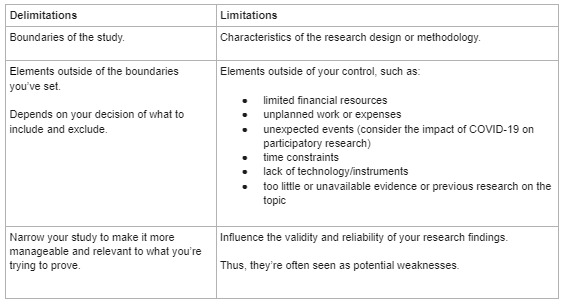
This chart explains the difference between delimitations and limitations. Delimitations are the boundaries of the study while the limitations are the characteristics of the research design or methodology.
Delimitations encompass the elements outside of the boundaries you've set and depends on your decision of what yo include and exclude. On the flip side, limitations are the elements outside of your control, such as:
- limited financial resources
- unplanned work or expenses
- unexpected events (for example, the COVID-19 pandemic)
- time constraints
- lack of technology/instruments
- unavailable evidence or previous research on the topic
Delimitations involve narrowing your study to make it more manageable and relevant to what you're trying to prove. Limitations influence the validity and reliability of your research findings. Limitations are seen as potential weaknesses in your research.
Example of the differences
To clarify these differences, go back to the limitations of the earlier example.
Limitations could comprise:
- Sample size : Not large enough to provide generalizable conclusions.
- Sampling approach : Non-probability sampling has increased bias risk. For instance, the researchers might not manage to capture the experiences of ethnic minority students.
- Methodological pitfalls : Research participants from an urban area (Paris) are likely to be more advantaged than students in rural areas. A study exploring the latter's experiences will probably yield very different findings.
Where do you write the scope and delimitations, and why?
It can be surprisingly empowering to realize you're restricted when conducting scholarly research. But this realization also makes writing up your research easier to grasp and makes it easier to see its limits and the expectations placed on it. Properly revealing this information serves your field and the greater scientific community.
Openly (but briefly) acknowledge the scope and delimitations of your study early on. The Abstract and Introduction sections are good places to set the parameters of your paper.
Next, discuss the scope and delimitations in greater detail in the Methods section. You'll need to do this to justify your methodological approach and data collection instruments, as well as analyses
At this point, spell out why these delimitations were set. What alternative options did you consider? Why did you reject alternatives? What could your study not address?
Let's say you're gathering data that can be derived from different but related experiments. You must convince the reader that the one you selected best suits your research question.
Finally, a solid paper will return to the scope and delimitations in the Findings or Discussion section. Doing so helps readers contextualize and interpret findings because the study's scope and methods influence the results.
For instance, agricultural field experiments carried out under irrigated conditions yield different results from experiments carried out without irrigation.
Being transparent about the scope and any outstanding issues increases your research's credibility and objectivity. It helps other researchers replicate your study and advance scientific understanding of the same topic (e.g., by adopting a different approach).
How do you write the scope and delimitations?
Define the scope and delimitations of your study before collecting data. This is critical. This step should be part of your research project planning.
Answering the following questions will help you address your scope and delimitations clearly and convincingly.
- What are your study's aims and objectives?
- Why did you carry out the study?
- What was the exact topic under investigation?
- Which factors and variables were included? And state why specific variables were omitted from the research scope.
- Who or what did the study explore? What was the target population?
- What was the study's location (geographical area) or setting (e.g., laboratory)?
- What was the timeframe within which you collected your data ?
- Consider a study exploring the differences between identical twins who were raised together versus identical twins who weren't. The data collection might span 5, 10, or more years.
- A study exploring a new immigration policy will cover the period since the policy came into effect and the present moment.
- How was the research conducted (research design)?
- Experimental research, qualitative, quantitative, or mixed-methods research, literature review, etc.
- What data collection tools and analysis techniques were used? e.g., If you chose quantitative methods, which statistical analysis techniques and software did you use?
- What did you find?
- What did you conclude?
Useful vocabulary for scope and delimitations
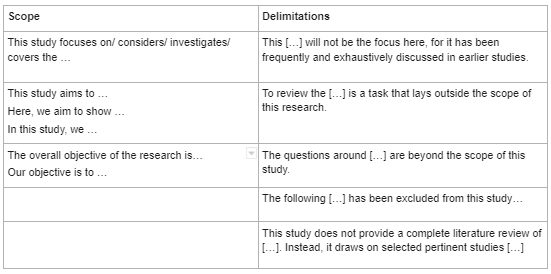
When explaining both the scope and delimitations, it's important to use the proper language to clearly state each.
For the scope , use the following language:
- This study focuses on/considers/investigates/covers the following:
- This study aims to . . . / Here, we aim to show . . . / In this study, we . . .
- The overall objective of the research is . . . / Our objective is to . . .
When stating the delimitations, use the following language:
- This [ . . . ] will not be the focus, for it has been frequently and exhaustively discusses in earlier studies.
- To review the [ . . . ] is a task that lies outside the scope of this study.
- The following [ . . . ] has been excluded from this study . . .
- This study does not provide a complete literature review of [ . . . ]. Instead, it draws on selected pertinent studies [ . . . ]
Analysis of a published scope
In one example, Simione and Gnagnarella (2020) compared the psychological and behavioral impact of COVID-19 on Italy's health workers and general population.
Here's a breakdown of the study's scope into smaller chunks and discussion of what works and why.
Also notable is that this study's delimitations include references to:
- Recruitment of participants: Convenience sampling
- Demographic characteristics of study participants: Age, sex, etc.
- Measurements methods: E.g., the death anxiety scale of the Existential Concerns Questionnaire (ECQ; van Bruggen et al., 2017) etc.
- Data analysis tool: The statistical software R
Analysis of published scope and delimitations
Scope of the study : Johnsson et al. (2019) explored the effect of in-hospital physiotherapy on postoperative physical capacity, physical activity, and lung function in patients who underwent lung cancer surgery.
The delimitations narrowed down the scope as follows:
Refine your scope, delimitations, and scientific English
English ability shouldn't limit how clear and impactful your research can be. Expert AJE editors are available to assess your science and polish your academic writing. See AJE services here .

The AJE Team
See our "Privacy Policy"
Scope and Delimitations in Academic Research
Table of contents
- 1.1 Examples of Elements Included in the Scope
- 2.1 Examples of Delimitations in Research
- 3 Determining the Scope and Delimitation
- 4 Writing the Scope and Delimitations Section
- 5 Conclusion
Understanding the scope and delimitations of a study is crucial for defining its parameters and ensuring focused research efforts. What are delimitations in a research study? These components establish the boundaries within which the research will operate and clarify what the study aims to explore and achieve. This article delves into the significance of clearly defining the scope and every delimitation, how they guide the research focus, and their roles in shaping the research process. Additionally, it provides insights into determining these aspects and articulating them effectively in a research proposal or paper. Transitioning smoothly into the main discussion, let’s explore the importance of scope in research, guiding the focus.
The importance of Clearly Defining the Scope of the Study for Guiding Research Focus
The scope of research delineates its extent or range of inquiry, setting clear parameters for what the study will cover. It’s a foundational aspect that guides every step of the research process, from the formulation of research questions to the interpretation of results. Defining the scope helps in focusing the research efforts, ensuring that the study remains manageable and within realistic bounds.
Understanding the scope and limitation of the study allows researchers to allocate resources efficiently, ensuring that every aspect of the study receives adequate attention. It also helps in avoiding the common pitfall of overreaching, which can dilute the research’s impact and make findings less actionable. By setting a defined scope, researchers can more easily communicate their work’s relevance, limitations and delimitations in the research process to stakeholders, enhancing the credibility and applicability of their findings. Furthermore, a well-defined scope can facilitate a more targeted and effective literature review, laying a solid foundation for the research study.
When navigating the complexities of defining a study’s scope, researchers might seek external support to ensure their research is concise, well-structured, and impactful. A writing service , PapersOwl offers a spectrum tailored to meet academic research’s unique demands. Their expertise can be particularly beneficial in refining research proposals, ensuring the scope is clearly communicated and aligned with academic standards. Engaging with such a service allows researchers to benefit from professional insights, which can enhance the coherence and focus of their work. This collaboration can be instrumental in identifying the most relevant study areas and avoiding unnecessary diversions. With PapersOwl’s support, researchers can ensure their project’s scope is well-defined and compellingly presented, making a strong case for its significance and feasibility. This partnership can be a strategic step towards achieving a study’s specific objectives, ensuring it contributes valuable insights within its defined boundaries.
Examples of Elements Included in the Scope
Defining the scope of a research project is akin to drawing a map for a journey; it outlines the terrain to be explored and the boundaries within which the exploration will occur. This clarity is essential for guiding the research process, ensuring the investigation remains focused and relevant. The scope encompasses various elements, each contributing to the overall direction and integrity of the study. Let’s delve into some of these key elements:
- Research Objectives : The specific aim the study is designed to achieve.
- Geographical Coverage: The physical or virtual locations where the research is conducted.
- Time Frame: The period during which the study takes place, which could range from a few days to several years.
- Subject: The specific topics or issues the research intends to address.
- Population Being Studied: The group of individuals, organizations, or phenomena being investigated.
These components of the scope serve as critical navigational tools in the research journey. They ensure that the study remains grounded in its objectives, relevant to its intended audience or population, and manageable within its temporal and geographical constraints. By carefully defining these elements at the outset, researchers can avoid common pitfalls such as scope creep, where the study’s focus broadens uncontrollably, potentially diluting its impact and significance. A well-defined scope is instrumental in crafting a focused, coherent, and impactful research project.
Role of Delimitations in Qualitative Research
Delimitations in research examples specify the boundaries set by the investigator on what the study will not cover, distinguishing them from limitations, which are potential weaknesses in the study not controlled by the researcher. Delimitations are choices made to narrow the scope of a study, focusing on specific aspects while excluding others. In the intricate tapestry of research design, delimitations play a pivotal role in sharpening the focus and enhancing the clarity of a study. By explicitly stating what the research will not explore, delimitations help prevent the dispersion of the research efforts across too broad an area, thereby increasing the depth and specificity of the investigation. This strategic narrowing allows researchers to concentrate their inquiries on areas most likely to yield impactful insights, making efficient use of available resources and time.
One might wonder how to establish these boundaries effectively without compromising the potential breadth of discovery. Here, the expertise provided by platforms like PapersOwl, particularly their research paper writing service service, becomes invaluable. Their seasoned professionals can offer guidance on crafting a research design that is both focused and flexible, assisting in identifying and justifying delimitations that enhance the study’s relevance and feasibility. Through such collaboration, researchers can balance the scope and delimitation of the study, ensuring that it remains grounded in its objectives while open to unforeseen insights.
Furthermore, acknowledging delimitations in a research paper demonstrates a researcher’s critical understanding of their study’s context and constraints, enhancing the credibility of their work. It shows a mindful engagement with the research process, recognizing that by setting deliberate boundaries, the study can delve more deeply and meaningfully into its chosen area of inquiry. Thus, when thoughtfully articulated with support from research paper writing help, like that offered by PapersOwl, delimitation in research becomes a testament to the rigor and integrity of its effort.
Examples of Delimitations in Research
Delimitations in research are akin to the guardrails on a highway; they keep the investigation on track and prevent it from veering into less relevant or overly broad territories. Below are some examples of how researchers can apply delimitations to fine-tune their investigations:
- Restricting the Study to Certain Age Groups: Focusing on a specific demographic, such as teenagers or the elderly.
- Geographic Locations: Limiting the research to a particular country, city, or region.
- Specific Periods: Studying a phenomenon during a particular time frame, ignoring other periods.
Setting these research delimitations is not about narrowing the vision of the research, but rather about sharpening its focus. It allows for a more thorough and nuanced exploration of the chosen subjects, leading to more precise findings and general delimitation meaning in research. Delimitations highlight the researcher’s awareness of the study’s scope and commitment to conducting a focused, manageable investigation.
Determining the Scope and Delimitation
Identifying the scope and delimitations of your research involves understanding the research problem deeply and recognizing what is feasible within the constraints of time, resources, and data availability. Strategies for determining these include:
- Reviewing existing literature to identify gaps and opportunities.
- Consulting with experts or advisors to refine research questions.
- Considering data availability and methodological constraints.
Balancing the scope and delimitations involves ensuring the research is neither too broad, unmanageable, nor too narrow, limiting its significance. Crafting a research project that strikes the right balance between breadth and depth is a nuanced task. It requires a researcher to be acutely aware of where their study begins and ends, what it encompasses, and what it intentionally leaves out. This equilibrium is not found in isolation but through a diligent exploration of the field and an understanding of how to best position one’s work within it. A key step in this process is identifying and sourcing relevant literature and data, which can significantly influence the scope of research.
Leveraging resources such as PapersOwl’s guide on how to find sources for research papers can prove invaluable in this phase. This platform provides insights into locating credible and relevant information, ensuring that researchers build their work upon a solid foundation of existing knowledge. By understanding how to navigate the vast, effective ocean of available data, researchers can make informed decisions about the direction and limits of their study. This meticulous preparation is crucial for defining the scope and delimitations and justifying them within the context of the research proposal or paper. It demonstrates a researcher’s commitment to rigor and depth, showing that their choices are informed by a comprehensive understanding of the subject and its existing body of literature.
Writing the Scope and Delimitations Section
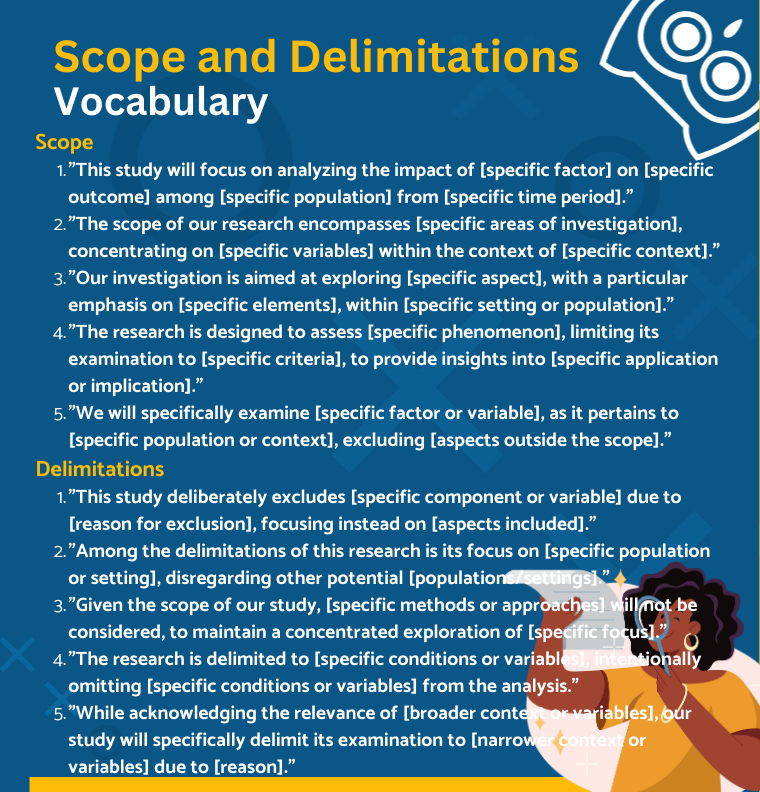
Articulating the scope and delimitations in a research paper or proposal is crucial for setting clear expectations. It should clearly define delimitations and what the study will and will not cover, providing a rationale for these choices. Effective wording and structure involve:
- Stating the research objectives and questions upfront.
- Describing the research methodology , data collection methods and analysis.
- Outlining the geographical coverage, time frame, and subject matter.
- Clearly stating the delimitations and the reasons behind them.
The presentation of the scope and delimitations within a research document not only guides the readers through the intentions of the research but also establishes a framework for evaluating the findings. It’s a critical section where transparency and precision are paramount, allowing the audience to grasp the extent of the study and the rationale behind its boundaries. This transparency is essential for the credibility of the research, as it demonstrates a conscious and deliberate effort to focus the investigation and acknowledges the existence of boundaries that the study does not cross.
To ensure clarity and impact, this section should seamlessly integrate with the overall narrative of the research proposal or paper. Researchers are advised to avoid jargon and overly technical language, making the research scope and delimitations accessible to a broader audience. This includes a layperson who may not have deep expertise in the field but an interest in the study’s outcomes. Additionally, it is beneficial to highlight how the defined study scope and delimitations contribute to addressing the research problem, filling knowledge gaps, or exploring uncharted territories.
Moreover, this part of the document offers an opportunity to discuss how the chosen delimitations enhance the study’s focus and depth. By justifying the exclusions, researchers can address potential critiques head-on, reinforcing the methodological choices and underscoring the study’s contribution to the field. This careful articulation ensures that the research is perceived as a well-thought-out endeavor, grounded in a strategic approach to inquiry.
The scope and delimitations of a study are foundational elements that guide the research process, setting clear boundaries and focusing efforts. By defining these aspects clearly, researchers can provide a clear roadmap for their investigation, ensuring that their work is both manageable and relevant. By consciously deciding what to exclude from the study, researchers can intensify their focus on the chosen subject, ensuring that the research efforts are concentrated where they are most needed and can be most effective. These self-imposed boundaries are critical for maintaining the study’s coherence and depth. This clarity not only aids in conducting the research but also in effectively communicating its implications, limits, and outcomes.
Readers also enjoyed

WHY WAIT? PLACE AN ORDER RIGHT NOW!
Just fill out the form, press the button, and have no worries!
We use cookies to give you the best experience possible. By continuing we’ll assume you board with our cookie policy.

Setting Limits and Focusing Your Study: Exploring scope and delimitation
As a researcher, it can be easy to get lost in the vast expanse of information and data available. Thus, when starting a research project, one of the most important things to consider is the scope and delimitation of the study. Setting limits and focusing your study is essential to ensure that the research project is manageable, relevant, and able to produce useful results. In this article, we will explore the importance of setting limits and focusing your study through an in-depth analysis of scope and delimitation.
Company Name 123
Lorem ipsum dolor sit amet, cu usu cibo vituperata, id ius probo maiestatis inciderint, sit eu vide volutpat.
Sign Up for More Insights
Table of Contents
Scope and Delimitation – Definition and difference
Scope refers to the range of the research project and the study limitations set in place to define the boundaries of the project and delimitation refers to the specific aspects of the research project that the study will focus on.
In simpler words, scope is the breadth of your study, while delimitation is the depth of your study.
Scope and delimitation are both essential components of a research project, and they are often confused with one another. The scope defines the parameters of the study, while delimitation sets the boundaries within those parameters. The scope and delimitation of a study are usually established early on in the research process and guide the rest of the project.
Types of Scope and Delimitation
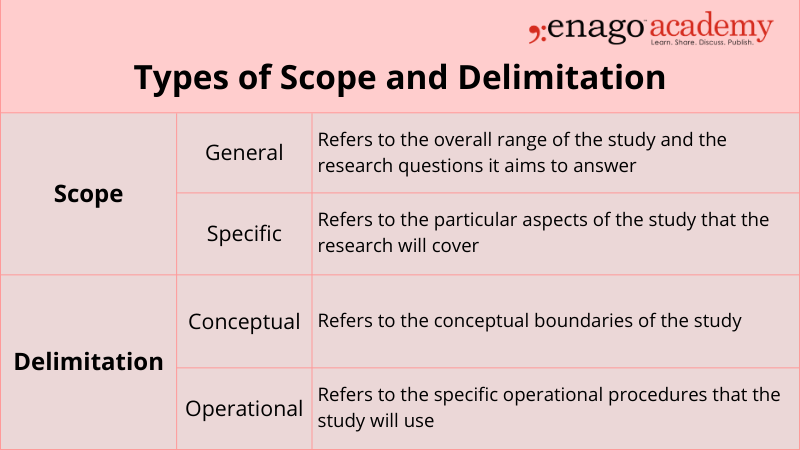
Significance of Scope and Delimitation
Setting limits and focusing your study through scope and delimitation is crucial for the following reasons:
- It allows researchers to define the research project’s boundaries, enabling them to focus on specific aspects of the project. This focus makes it easier to gather relevant data and avoid unnecessary information that might complicate the study’s results.
- Setting limits and focusing your study through scope and delimitation enables the researcher to stay within the parameters of the project’s resources.
- A well-defined scope and delimitation ensure that the research project can be completed within the available resources, such as time and budget, while still achieving the project’s objectives.
5 Steps to Setting Limits and Defining the Scope and Delimitation of Your Study

There are a few steps that you can take to set limits and focus your study.
1. Identify your research question or topic
The first step is to identify what you are interested in learning about. The research question should be specific, measurable, achievable, relevant, and time-bound (SMART). Once you have a research question or topic, you can start to narrow your focus.
2. Consider the key terms or concepts related to your topic
What are the important terms or concepts that you need to understand in order to answer your research question? Consider all available resources, such as time, budget, and data availability, when setting scope and delimitation.
The scope and delimitation should be established within the parameters of the available resources. Once you have identified the key terms or concepts, you can start to develop a glossary or list of definitions.
3. Consider the different perspectives on your topic
There are often different perspectives on any given topic. Get feedback on the proposed scope and delimitation. Advisors can provide guidance on the feasibility of the study and offer suggestions for improvement.
It is important to consider all of the different perspectives in order to get a well-rounded understanding of your topic.
4. Narrow your focus
Be specific and concise when setting scope and delimitation. The parameters of the study should be clearly defined to avoid ambiguity and ensure that the study is focused on relevant aspects of the research question.
This means deciding which aspects of your topic you will focus on and which aspects you will eliminate.
5. Develop the final research plan
Revisit and revise the scope and delimitation as needed. As the research project progresses, the scope and delimitation may need to be adjusted to ensure that the study remains focused on the research question and can produce useful results. This plan should include your research goals, methods, and timeline.
Examples of Scope and Delimitation
To better understand scope and delimitation, let us consider two examples of research questions and how scope and delimitation would apply to them.
Research question: What are the effects of social media on mental health?
Scope: The scope of the study will focus on the impact of social media on the mental health of young adults aged 18-24 in the United States.
Delimitation: The study will specifically examine the following aspects of social media: frequency of use, types of social media platforms used, and the impact of social media on self-esteem and body image.
Research question: What are the factors that influence employee job satisfaction in the healthcare industry?
Scope: The scope of the study will focus on employee job satisfaction in the healthcare industry in the United States.
Delimitation: The study will specifically examine the following factors that influence employee job satisfaction: salary, work-life balance, job security, and opportunities for career growth.
Setting limits and defining the scope and delimitation of a research study is essential to conducting effective research. By doing so, researchers can ensure that their study is focused, manageable, and feasible within the given time frame and resources. It can also help to identify areas that require further study, providing a foundation for future research.
So, the next time you embark on a research project, don’t forget to set clear limits and define the scope and delimitation of your study. It may seem like a tedious task, but it can ultimately lead to more meaningful and impactful research. And if you still can’t find a solution, reach out to Enago Academy using #AskEnago and tag @EnagoAcademy on Twitter , Facebook , and Quora .
Frequently Asked Questions
The scope in research refers to the boundaries and extent of a study, defining its specific objectives, target population, variables, methods, and limitations, which helps researchers focus and provide a clear understanding of what will be investigated.
Delimitation in research defines the specific boundaries and limitations of a study, such as geographical, temporal, or conceptual constraints, outlining what will be excluded or not within the scope of investigation, providing clarity and ensuring the study remains focused and manageable.
To write a scope; 1. Clearly define research objectives. 2. Identify specific research questions. 3. Determine the target population for the study. 4. Outline the variables to be investigated. 5. Establish limitations and constraints. 6. Set boundaries and extent of the investigation. 7. Ensure focus, clarity, and manageability. 8. Provide context for the research project.
To write delimitations; 1. Identify geographical boundaries or constraints. 2. Define the specific time period or timeframe of the study. 3. Specify the sample size or selection criteria. 4. Clarify any demographic limitations (e.g., age, gender, occupation). 5. Address any limitations related to data collection methods. 6. Consider limitations regarding the availability of resources or data. 7. Exclude specific variables or factors from the scope of the study. 8. Clearly state any conceptual boundaries or theoretical frameworks. 9. Acknowledge any potential biases or constraints in the research design. 10. Ensure that the delimitations provide a clear focus and scope for the study.
What is an example of delimitation of the study?
Thank you 💕
Thank You very simplified🩷
Thanks, I find this article very helpful
Rate this article Cancel Reply
Your email address will not be published.

Enago Academy's Most Popular Articles

- Promoting Research
Graphical Abstracts Vs. Infographics: Best practices for using visual illustrations for increased research impact
Dr. Sarah Chen stared at her computer screen, her eyes staring at her recently published…

- Publishing Research
10 Tips to Prevent Research Papers From Being Retracted
Research paper retractions represent a critical event in the scientific community. When a published article…

- Industry News
Google Releases 2024 Scholar Metrics, Evaluates Impact of Scholarly Articles
Google has released its 2024 Scholar Metrics, assessing scholarly articles from 2019 to 2023. This…
![how to write a scope and delimitation in research What is Academic Integrity and How to Uphold it [FREE CHECKLIST]](https://www.enago.com/academy/wp-content/uploads/2024/05/FeatureImages-59-210x136.png)
Ensuring Academic Integrity and Transparency in Academic Research: A comprehensive checklist for researchers
Academic integrity is the foundation upon which the credibility and value of scientific findings are…

- Old Webinars
- Webinar Mobile App
Improving Research Manuscripts Using AI-Powered Insights: Enago reports for effective research communication
Language Quality Importance in Academia AI in Evaluating Language Quality Enago Language Reports Live Demo…
How to Optimize Your Research Process: A step-by-step guide
Choosing the Right Analytical Approach: Thematic analysis vs. content analysis for…
Research Recommendations – Guiding policy-makers for evidence-based decision making
Demystifying the Role of Confounding Variables in Research

Sign-up to read more
Subscribe for free to get unrestricted access to all our resources on research writing and academic publishing including:
- 2000+ blog articles
- 50+ Webinars
- 10+ Expert podcasts
- 50+ Infographics
- 10+ Checklists
- Research Guides
We hate spam too. We promise to protect your privacy and never spam you.
- Reporting Research
- AI in Academia
- Career Corner
- Diversity and Inclusion
- Infographics
- Expert Video Library
- Other Resources
- Enago Learn
- Upcoming & On-Demand Webinars
- Open Access Week 2024
- Peer Review Week 2024
- Conference Videos
- Enago Report
- Journal Finder
- Enago Plagiarism & AI Grammar Check
- Editing Services
- Publication Support Services
- Research Impact
- Translation Services
- Publication solutions
- AI-Based Solutions
- Thought Leadership
- Call for Articles
- Call for Speakers
- Author Training
- Edit Profile
I am looking for Editing/ Proofreading services for my manuscript Tentative date of next journal submission:

What factors would influence the future of open access (OA) publishing?
How to Write the Scope of Research: A Comprehensive Guide [Plus Examples]
Learn to write a clear, effective research scope. This guide covers key elements, instructions, and examples to enhance your research writing skills.
Glice Martineau
Jul 29, 2024
![how to write a scope and delimitation in research How to Write the Scope of Research: A Comprehensive Guide [Plus Examples]](https://listeningblog.wpenginepowered.com/wp-content/uploads/2024/10/3788.jpg)
Image by Freepik
The scope of research is a crucial element in any academic study , defining the boundaries and focus of your investigation, which is crucial for the scope of the study. This article will guide you through the process of writing a well-defined scope, ensuring your research paper is manageable, impactful, and achievable.
If you’re embarking on your first academic writing journey, understanding how to craft an effective scope will make your research easier and more focused.

Understanding the Purpose of Research Scope
The scope of a study explains the extent to which the research area will be explored in the work and specifies the parameters within which the study will be operating, guided by the scope of a research design.
It’s essential to define the scope of research early in the process, as it helps to guide the research design:
1. Clarify research boundaries: By setting clear limits, you ensure that your study remains focused and doesn’t veer off into tangential areas.
2. Focus on specific research objectives : A well-defined scope helps you concentrate on the most relevant aspects of the research, making it easier to address your research questions effectively.
3. Scope of study considerations. Ensure feasibility of the study: By considering the scope and delimitations, you can evaluate whether your research project is manageable within the given timeframe and resources.
Image by drobotdean on Freepik
Key Elements of a Research Scope
When writing the scope of your study, consider including the following elements:
1. Research problem : Clearly state the central issue your study aims to address. 2. Research questions: Formulate specific questions that your study will answer. 3. Study limitations: Acknowledge any constraints or potential Biases relevant to the research study that might affect your research. 4. Target population: Define the group of individuals or entities your research will focus on. 5. Timeframe: Specify the duration of your study and any relevant time-based parameters. 6. Geographical boundaries: If applicable, indicate the geographical location(s) involved in the study.
Step-by-Step Guide to Writing a Research Scope
1. identify your research problem.
Start by narrowing down your broad research area to a specific problem. This helps define the purpose of your study and guides the rest of your scope.
For example, instead of studying “The effects of social media,” you might explore “The impact of Instagram usage on body image among young adults aged 18-24 in the United States.”
2. Formulate Clear Research Questions
Develop focused research questions that directly relate to your research problem.
These questions should be specific, measurable, and achievable within your study’s constraints.
For instance:
- “How does daily Instagram usage correlate with body satisfaction scores among young adults?”
- “What specific Instagram features are most strongly associated with negative body image perceptions?”
3. Define Study Limitations
Acknowledge the boundaries and limitations of your research, understanding how they shape the scope of your research study. This might include methodological constraints , sample size restrictions, or potential biases .
Be transparent about what your study excludes and why.
For example, you might state that your study focuses solely on Instagram and doesn’t explore other social media platforms.
4. Specify the Target Population
Clearly define the group you’ll be studying. Consider factors such as age range, geographical location, and any specific characteristics relevant to your research.
For instance: “This study will focus on young adults aged 18-24, residing in urban areas of the United States, who use Instagram daily.”
5. Establish a Realistic Timeframe
Determine the duration of your study and any time-based parameters for data collection. This helps in planning your research methodology and ensures the project is manageable.
For example: “This study will be conducted over a six-month period, with data collection occurring during the first three months.”
6. Set Geographical Boundaries
If your research is location-specific, clearly state the geographical scope.
This could be as broad as a country or as specific as a particular city or institution.
Examples of Well-Written Research Scopes
Research scope in social sciences:.
“This study explores the impact of Instagram usage on body image among young adults aged 18-24 in New York City. The research will focus on daily users of the platform and examine correlations between usage patterns and body satisfaction scores. The study will be conducted over a six-month period, using a mixed-methods approach including surveys and in-depth interviews. While the study acknowledges the broader context of social media influence, it will not explore other platforms or age groups.”
Research Scope in Medical Research:
“This research project aims to evaluate the effectiveness of a new cognitive behavioral therapy (CBT) approach in treating anxiety disorders among adults aged 30-50. The study will be conducted in three major hospitals in Chicago over a 12-month period. While the study will assess various anxiety disorders, it will exclude patients with comorbid depression. The research methodology will involve randomized controlled trials with a sample size of 200 participants.”
Common Pitfalls to Avoid When Writing a Research Scope
1. Overly broad or narrow scopes: Strive for a balance that allows for meaningful exploration without becoming unmanageable. 2. Ambiguous language: Use clear, specific terms to define your scope and delimitations. 3. Unrealistic expectations: Consider the feasibility of your research within the given timeframe and resources.
Writing a well-defined scope of research is crucial for the success of your academic research or research paper. It helps you curate a focused, manageable, and impactful study by clearly outlining the boundaries within which your research will operate.
By following the steps outlined in this guide and learning from the examples provided, you can craft a scope that sets your research up for success.
Remember, the scope of a study explains the extent of your exploration and makes it easier for both you and your readers to understand the parameters of your work.
As you progress in your research process, don’t hesitate to revisit and refine your scope to ensure it remains aligned with your research objectives and methodology.
Easily pronounces technical words in any field
Academic Writing
Research Paper
Scope of Research
Recent articles

What are the Responsibilities of a Cosigner in a Student Loan?
Aug 6, 2024
Financial Aid
College Funding
Cosigner Responsibilities
Student Loans

10 Best Productivity Books
Aug 13, 2024
Productivity Books
Time Management
Efficiency Tips
Self Improvement
Goal Setting

The Grad Student's Guide to Building a Study System That Actually Works
Derek Pankaew
Sep 17, 2024
active learning
work-life balance
academic productivity
time management
study techniques
graduate studies

The U.S. Cities with the Most Productivity Hackers
Oct 7, 2024
Educational resources and simple solutions for your research journey

Decoding the Scope and Delimitations of the Study in Research

Scope and delimitations of the study are two essential elements of a research paper or thesis that help to contextualize and convey the focus and boundaries of a research study. This allows readers to understand the research focus and the kind of information to expect. For researchers, especially students and early career researchers, understanding the meaning and purpose of the scope and delimitation of a study is crucial to craft a well-defined and impactful research project. In this article, we delve into the core concepts of scope and delimitation in a study, providing insightful examples, and practical tips on how to effectively incorporate them into your research endeavors.
Table of Contents
What is scope and delimitation in research
The scope of a research paper explains the context and framework for the study, outlines the extent, variables, or dimensions that will be investigated, and provides details of the parameters within which the study is conducted. Delimitations in research , on the other hand, refer to the limitations imposed on the study. It identifies aspects of the topic that will not be covered in the research, conveys why these choices were made, and how this will affect the outcome of the research. By narrowing down the scope and defining delimitations, researchers can ensure focused research and avoid pitfalls, which ensures the study remains feasible and attainable.
Example of scope and delimitation of a study
A researcher might want to study the effects of regular physical exercise on the health of senior citizens. This would be the broad scope of the study, after which the researcher would refine the scope by excluding specific groups of senior citizens, perhaps based on their age, gender, geographical location, cultural influences, and sample sizes. These then, would form the delimitations of the study; in other words, elements that describe the boundaries of the research.
The purpose of scope and delimitation in a study
The purpose of scope and delimitation in a study is to establish clear boundaries and focus for the research. This allows researchers to avoid ambiguity, set achievable objectives, and manage their project efficiently, ultimately leading to more credible and meaningful findings in their study. The scope and delimitation of a study serve several important purposes, including:
- Establishing clarity: Clearly defining the scope and delimitation of a study helps researchers and readers alike understand the boundaries of the investigation and what to expect from it.
- Focus and relevance: By setting the scope, researchers can concentrate on specific research questions, preventing the study from becoming too broad or irrelevant.
- Feasibility: Delimitations of the study prevent researchers from taking on too unrealistic or unmanageable tasks, making the research more achievable.
- Avoiding ambiguity: A well-defined scope and delimitation of the study minimizes any confusion or misinterpretation regarding the research objectives and methods.
Given the importance of both the scope and delimitations of a study, it is imperative to ensure that they are mentioned early on in the research manuscript. Most experts agree that the scope of research should be mentioned as part of the introduction and the delimitations must be mentioned as part of the methods section. Now that we’ve covered the scope and delimitation meaning and purpose, we look at how to write each of these sections.
How to write the scope of the study in research
When writing the scope of the study, remain focused on what you hope to achieve. Broadening the scope too much might make it too generic while narrowing it down too much may affect the way it would be interpreted. Ensure the scope of the study is clear, concise and accurate. Conduct a thorough literature review to understand existing literature, which will help identify gaps and refine the scope of your study.
It is helpful if you structure the scope in a way that answers the Six Ws – questions whose answers are considered basic in information-gathering.
Why: State the purpose of the research by articulating the research objectives and questions you aim to address in your study.
What: Outline the specific topic to be studied, while mentioning the variables, concepts, or aspects central to your research; these will define the extent of your study.
Where: Provide the setting or geographical location where the research study will be conducted.
When : Mention the specific timeframe within which the research data will be collected.
Who : Specify the sample size for the study and the profile of the population they will be drawn from.
How : Explain the research methodology, research design, and tools and analysis techniques.
How to write the delimitations of a study in research
When writing the delimitations of the study, researchers must provide all the details clearly and precisely. Writing the delimitations of the study requires a systematic approach to narrow down the research’s focus and establish boundaries. Follow these steps to craft delimitations effectively:
- Clearly understand the research objectives and questions you intend to address in your study.
- Conduct a comprehensive literature review to identify gaps and areas that have already been extensively covered. This helps to avoid redundancies and home in on a unique issue.
- Clearly state what aspects, variables, or factors you will be excluding in your research; mention available alternatives, if any, and why these alternatives were rejected.
- Explain how you the delimitations were set, and they contribute to the feasibility and relevance of your study, and how they align with the research objectives.
- Be sure to acknowledge limitations in your research, such as constraints related to time, resources, or data availability.
Being transparent ensures credibility, while explaining why the delimitations of your study could not be overcome with standard research methods backed up by scientific evidence can help readers understand the context better.

Differentiating between delimitations and limitations
Most early career researchers get confused and often use these two terms interchangeably which is wrong. Delimitations of a study refer to the set boundaries and specific parameters within which the research is carried out. They help narrow down your focus and makes it more relevant to what you are trying to prove.
Meanwhile, limitations in a study refer to the validity and reliability of the research being conducted. They are those elements of your study that are usually out of your immediate control but are still able to affect your findings in some way. In other words, limitation are potential weaknesses of your research.
In conclusion, scope and delimitation of a study are vital elements that shape the trajectory of your research study. The above explanations will have hopefully helped you better understand the scope and delimitations meaning, purpose, and importance in crafting focused, feasible, and impactful research studies. Be sure to follow the simple techniques to write the scope and delimitations of the study to embark on your research journey with clarity and confidence. Happy researching!
Editage All Access is a subscription-based platform that unifies the best AI tools and services designed to speed up, simplify, and streamline every step of a researcher’s journey. The Editage All Access Pack is a one-of-a-kind subscription that unlocks full access to an AI writing assistant, literature recommender, journal finder, scientific illustration tool, and exclusive discounts on professional publication services from Editage.
Based on 22+ years of experience in academia, Editage All Access empowers researchers to put their best research forward and move closer to success. Explore our top AI Tools pack, AI Tools + Publication Services pack, or Build Your Own Plan. Find everything a researcher needs to succeed, all in one place – Get All Access now starting at just $14 a month !
Related Posts

Paperpal Review: Key Features, Pricing Plans, and How-to-Use

How to Structure a Dissertation?

Research Limitations & Delimitations
By: Derek Jansen (MBA) | Expert Reviewed By: David Phair (PhD) | September 2022

Overview: Limitations vs Delimitations
- Are they the same?
- What are research limitations
- What are research delimitations
- Limitations vs delimitations
First things first…
Let’s start with the most important takeaway point of this post – research limitations and research delimitations are not the same – but they are related to each other (we’ll unpack that a little later). So, if you hear someone using these two words interchangeably, be sure to share this post with them!
Research Limitations
Research limitations are, at the simplest level, the weaknesses of the study , based on factors that are often outside of your control as the researcher. These factors could include things like time , access to funding, equipment , data or participants . For example, if you weren’t able to access a random sample of participants for your study and had to adopt a convenience sampling strategy instead, that would impact the generalizability of your findings and therefore reflect a limitation of your study.
Research limitations can also emerge from the research design itself . For example, if you were undertaking a correlational study, you wouldn’t be able to infer causality (since correlation doesn’t mean certain causation). Similarly, if you utilised online surveys to collect data from your participants, you naturally wouldn’t be able to get the same degree of rich data that you would from in-person interviews .
Simply put, research limitations reflect the shortcomings of a study , based on practical (or theoretical) constraints that the researcher faced. These shortcomings limit what you can conclude from a study, but at the same time, present a foundation for future research . Importantly, all research has limitations , so there’s no need to hide anything here – as long as you discuss how the limitations might affect your findings, it’s all good.
Research Delimitations
Alright, now that we’ve unpacked the limitations, let’s move on to the delimitations .
Research delimitations are similar to limitations in that they also “ limit ” the study, but their focus is entirely different. Specifically, the delimitations of a study refer to the scope of the research aims and research questions . In other words, delimitations reflect the choices you, as the researcher, intentionally make in terms of what you will and won’t try to achieve with your study. In other words, what your research aims and research questions will and won’t include.
As we’ve spoken about many times before, it’s important to have a tight, narrow focus for your research, so that you can dive deeply into your topic, apply your energy to one specific area and develop meaningful insights. If you have an overly broad scope or unfocused topic, your research will often pull in multiple, even opposing directions, and you’ll just land up with a muddy mess of findings .
So, the delimitations section is where you’ll clearly state what your research aims and research questions will focus on – and just as importantly, what they will exclude . For example, you might investigate a widespread phenomenon, but choose to focus your study on a specific age group, ethnicity or gender. Similarly, your study may focus exclusively on one country, city or even organization. As long as the scope is well justified (in other words, it represents a novel, valuable research topic), this is perfectly acceptable – in fact, it’s essential. Remember, focus is your friend.
Need a helping hand?
Conclusion: Limitations vs Delimitations
Ok, so let’s recap.
Research limitations and research delimitations are related in that they both refer to “limits” within a study. But, they are distinctly different. Limitations reflect the shortcomings of your study, based on practical or theoretical constraints that you faced.
Contrasted to that, delimitations reflect the choices that you made in terms of the focus and scope of your research aims and research questions. If you want to learn more about research aims and questions, you can check out this video post , where we unpack those concepts in detail.

You Might Also Like:

How To Choose A Tutor For Your Dissertation
Hiring the right tutor for your dissertation or thesis can make the difference between passing and failing. Here’s what you need to consider.

5 Signs You Need A Dissertation Helper
Discover the 5 signs that suggest you need a dissertation helper to get unstuck, finish your degree and get your life back.

Writing A Dissertation While Working: A How-To Guide
Struggling to balance your dissertation with a full-time job and family? Learn practical strategies to achieve success.

How To Review & Understand Academic Literature Quickly
Learn how to fast-track your literature review by reading with intention and clarity. Dr E and Amy Murdock explain how.

Dissertation Writing Services: Far Worse Than You Think
Thinking about using a dissertation or thesis writing service? You might want to reconsider that move. Here’s what you need to know.
📄 FREE TEMPLATES
Research Topic Ideation
Proposal Writing
Literature Review
Methodology & Analysis
Academic Writing
Referencing & Citing
Apps, Tools & Tricks
The Grad Coach Podcast
19 Comments
Good clarification of ideas on how a researcher ought to do during Process of choice
Thank you so much for this very simple but explicit explanation on limitation and delimitation. It has so helped me to develop my masters proposal. hope to recieve more from your site as time progresses
Thank you for this explanation – very clear.
Thanks for the explanation, really got it well.
This website is really helpful for my masters proposal
Thank you very much for helping to explain these two terms
I spent almost the whole day trying to figure out the differences
when I came across your notes everything became very clear
thanks for the clearly outlined explanation on the two terms, limitation and delimitation.
Very helpful Many thanks 🙏
Excellent it resolved my conflict .
I would like you to assist me please. If in my Research, I interviewed some participants and I submitted Questionnaires to other participants to answered to the questions, in the same organization, Is this a Qualitative methodology , a Quantitative Methodology or is it a Mixture Methodology I have used in my research? Please help me
How do I cite this article in APA format
Really so great ,finally have understood it’s difference now
Getting more clear regarding Limitations and Delimitation and concepts
I really appreciate your apt and precise explanation of the two concepts namely ; Limitations and Delimitations.
This is a good sources of research information for learners.
thank you for this, very helpful to researchers
Very good explained
Great and clear explanation, after a long confusion period on the two words, i can now explain to someone with ease.
Submit a Comment Cancel reply
Your email address will not be published. Required fields are marked *
Save my name, email, and website in this browser for the next time I comment.
Submit Comment
- Print Friendly

Scope and Delimitation
Ai generator.
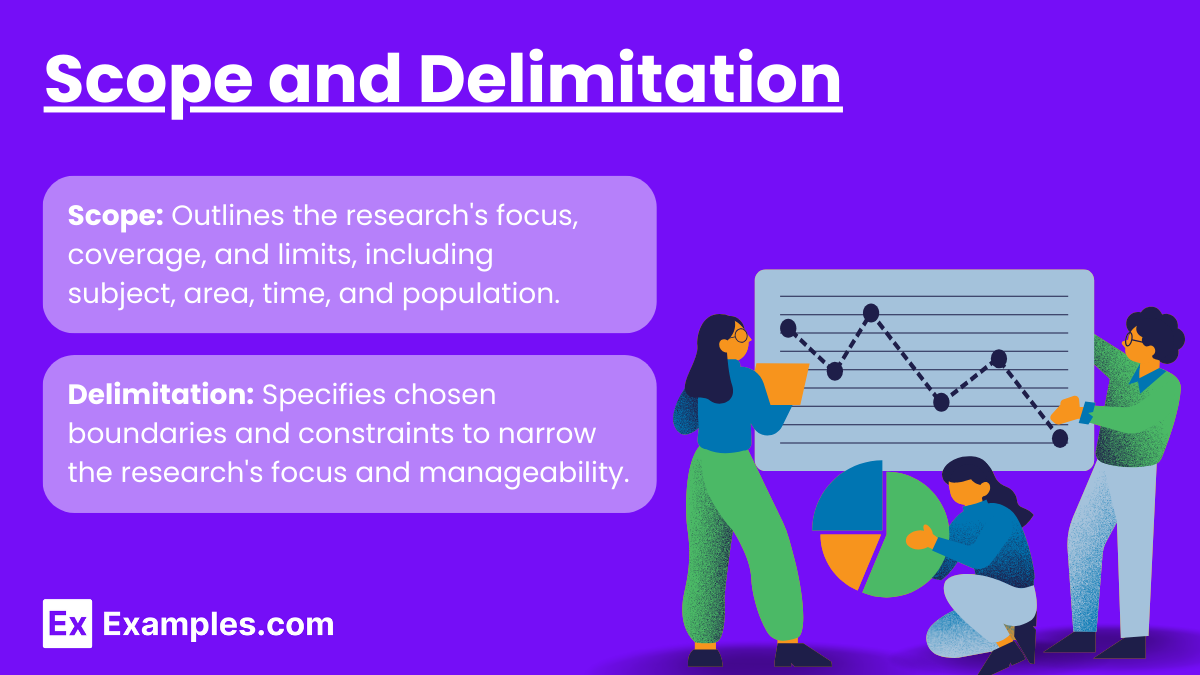
Scope and delimitation are crucial components of a research project, outlining its boundaries and specifying what is included and excluded. The scope details the extent of the study, including its aims, geographical area, time frame, and subjects involved. Delimitations, on the other hand, define the parameters set by the researcher, such as limitations on the scope, methodology, or demographic constraints, helping to focus the research effectively.
What Is Scope and Delimitation?
Scope: The scope of a research project encompasses its objectives, geographical coverage, time period, and subjects or variables studied. It outlines the breadth and depth of the investigation, detailing what the researcher aims to explore or analyze.
Delimitation: Delimitation refers to the self-imposed boundaries set by the researcher within a study. These can include the choice of methodology, theoretical framework, or specific aspects and variables excluded from the research. Delimitations help narrow the focus, making the study more manageable and specific.
Types of Scope and Delimitation
Types of Scope:
- Content Scope: Refers to the range of topics and subtopics that the research will cover.
- Geographical Scope: Defines the physical or virtual locations where the research is conducted.
- Temporal Scope: Specifies the time period during which the data is collected or the events are analyzed.
- Population Scope: Determines the groups, communities, or demographics from which data will be collected.
Types of Delimitation:
- Methodological Delimitation: Involves selecting specific methods or procedures that limit the way data is collected or analyzed.
- Theoretical Delimitation: Focuses the study on a particular theory or set of assumptions, excluding others.
- Data Delimitation: Restricts the range or type of data collected, such as focusing only on qualitative or quantitative data.
- Objective Delimitation: Narrows the research aims and objectives, focusing on specific questions or hypotheses.
Significance of Scope and Delimitation
The significance of scope and delimitation in research is crucial for several reasons:
- Clarity and Focus : Defining the scope helps to clearly establish what the research will cover, ensuring that the study remains focused on relevant questions and objectives. Delimitations further refine this focus by setting clear boundaries, which prevents the research from becoming too broad or vague.
- Feasibility : By setting a realistic scope and appropriate delimitations, researchers can ensure that the project is manageable and can be completed within the allotted time and resources. This makes the study more practical and achievable.
- Validity and Precision : Limiting the scope and delimitations helps in targeting the research more precisely to the area of interest. This enhances the validity of the results as the study avoids extraneous variables and focuses on the key factors.
- Expectation Setting : Both scope and delimitations help in setting the right expectations for the audience or stakeholders. They provide a clear understanding of what the study intends to explore and what it will not address, making the findings more transparent and interpretable.
- Resource Optimization : By clearly defining what is included and excluded in the study, researchers can better allocate resources such as time, manpower, and finances. This optimization prevents wastage of resources on irrelevant or peripheral areas.
Importance of Writing the Scope and Delimitations
Writing the scope and delimitations clearly in a research study is fundamentally important for several key reasons:
- Establishes what the study will cover and what it will not.
- Helps in setting clear objectives and goals for the research.
- Prevents unnecessary expansion of the study, maintaining focus.
- Demonstrates the researcher’s awareness of the study’s limitations.
- Increases transparency, allowing readers to understand the study’s context.
- Acknowledges potential weaknesses, making the research more credible.
- Helps in efficient allocation of time, money, and effort.
- Prevents wastage of resources on areas outside the study’s focus.
- Allows for better planning and execution of research activities.
- Guides the selection of appropriate data sources and methods.
- Ensures data collection remains relevant to the research questions.
- Reduces the risk of collecting irrelevant or excessive data.
- Provides a clear framework for analyzing the collected data.
- Helps in identifying relevant patterns and trends within the defined boundaries.
- Simplifies the interpretation of results, making conclusions more accurate.
- Ensures the research remains aligned with its intended purpose.
- Enhances the applicability of the study’s findings to real-world situations.
- Makes it easier for readers to relate to the study’s outcomes.
- Provides clear guidelines for future researchers to replicate the study.
- Ensures consistency and reliability in research methodology.
- Encourages further exploration within the defined scope.
Difference Between Delimitations and Limitations
Scope and delimitation examples in research.
Here are examples of how scope and delimitation can be defined in different types of research projects:
- Scope : The study focuses on evaluating the effectiveness of a new diabetes management program within urban community clinics over a period of one year. It includes adult patients aged 30-60 who are newly diagnosed with type 2 diabetes.
- Delimitation : The study excludes patients who have been managing diabetes for more than a year or have other chronic conditions, focusing solely on newly diagnosed individuals to isolate the effects of the management program.
- Scope : This research examines the impact of deforestation on river ecosystems in the Amazon Basin, specifically looking at water quality parameters and biodiversity indexes over five years.
- Delimitation : The study limits its analysis to tributaries directly affected by deforestation, excluding regions where industrial pollution might skew the natural impact of tree loss.
- Scope : The project aims to assess the outcomes of a new digital learning initiative on middle school students’ performance in public schools across three states during the current academic year.
- Delimitation : It focuses on public schools that have implemented the program in its entirety, excluding private and charter schools to maintain consistency in educational environment and resources.
- Scope : The research is designed to gather consumer feedback on a new line of ergonomic office chairs, targeting working professionals between the ages of 25 and 45 in the United States.
- Delimitation : The study is confined to online surveys and virtual focus groups, deliberately excluding in-person feedback sessions to expedite data collection and reduce costs.
- Scope : This study explores the influence of the Harlem Renaissance on modern American literature, focusing on the works published between 1920 and 1935 that directly reference or are inspired by this cultural movement.
- Delimitation : The research limits its scope to literary works in English, excluding non-English works and other forms of art like painting or music to concentrate on literary influences.
Scope and Delimitation Examples in Quantitative Research
In quantitative research, where precise measurement and statistical analysis are paramount, clearly defined scope and delimitations are crucial. Here are examples to illustrate how scope and delimitations can be structured in such studies:
- Scope : The study is designed to evaluate the efficacy and safety of a new cholesterol-lowering drug among adults aged 40-65 over a six-month period, using randomized controlled trials across ten different sites in Europe.
- Delimitation : The trial excludes individuals with pre-existing conditions such as diabetes or kidney disease to prevent confounding variables that could affect the drug’s perceived effectiveness or safety profile.
- Scope : This research quantitatively assesses the economic impact of introducing a minimum wage policy in the retail sector within New York City, measuring changes in employment rates and business revenues over two years.
- Delimitation : The study confines its analysis to the retail sector, excluding other sectors like hospitality or healthcare to isolate the specific effects of the wage increase on a similar type of business.
- Scope : The study focuses on comparing standardized test scores between students in charter schools and public schools within the Midwest region of the United States, analyzing data collected over the current academic year.
- Delimitation : It only includes schools that have fully implemented Common Core standards, ensuring that curriculum alignment is maintained across the sample to enhance comparability.
- Scope : This research measures customer satisfaction levels regarding network coverage, customer service, and pricing among users aged 18-55 across the United States.
- Delimitation : The survey targets only current subscribers who have used the service for at least six months, excluding new users to focus on experienced perceptions and reduce the variability brought by initial service impressions.
- Scope : The quantitative study aims to examine the relationship between high-protein diets and heart health in individuals over 50 years old, tracking heart disease markers and overall health outcomes for five years.
- Delimitation : Participants with a history of dietary restrictions or chronic illnesses other than heart-related conditions are excluded to focus solely on the impact of diet on heart health without external medical factors.
Scope and Delimitation Examples about Business
Here are several examples of how scope and delimitation can be defined in business-related research, each tailored to different areas of business studies:
- Scope : This study aims to assess the feasibility and potential profitability of introducing an eco-friendly clothing line in the European market. It analyzes market trends, consumer preferences, and competition within the next two years.
- Delimitation : The research is limited to five major European countries (Germany, France, UK, Spain, and Italy) and excludes other global markets to specifically understand European consumer behavior and regulatory impacts on sustainability.
- Scope : The project focuses on evaluating the impact of remote working on employee productivity within a multinational corporation, utilizing data from productivity software and employee surveys collected over the past year.
- Delimitation : It only considers employees who have been with the company for at least two years to exclude the learning curve effects in new hires and to focus on data reflecting more established work patterns.
- Scope : This research quantitatively examines the factors that influence customer loyalty and retention rates in the online retail sector, focusing on customers aged 25-45.
- Delimitation : The study limits its analysis to customers who have made at least three purchases in the past year to focus on repeat customers rather than new or occasional shoppers.
- Scope : The study aims to benchmark the financial performance of tech startups in Silicon Valley over the last five years, focusing on key metrics such as revenue growth, profit margins, and capital efficiency.
- Delimitation : Only startups that have received Series A funding or beyond are included, excluding early-stage startups without significant funding to ensure the analysis is centered on companies with comparable levels of investment.
- Scope : This study assesses the brand perception of a newly launched luxury watch brand among high-income consumers in North America, using online surveys and social media sentiment analysis collected over the six months following the launch.
- Delimitation : The research targets only high-income consumers (defined as those earning above $100,000 annually) to ensure the feedback and data are relevant to the brand’s target market.
Scope and Delimitation Example about Working Students
1. academic performance.
The Impact of Part-time Employment on Academic Performance Among University Students
This study aims to examine the relationship between part-time employment and academic performance among undergraduate students at public universities in California during the 2023-2024 academic year. It focuses on how working part-time affects students’ GPA, study habits, and overall time management. The study will utilize quantitative data from academic records and surveys to assess these impacts.
Delimitation
The study is limited to undergraduate students who are employed part-time, working between 10 to 30 hours per week. It excludes:
- Graduate students, to maintain focus on the undergraduate experience.
- Students working fewer than 10 hours or more than 30 hours per week, to analyze the impact within a specific range of part-time employment.
- Students from private universities, to ensure consistency in the educational environment and resources available at public universities.
- Non-traditional students (over the age of 25) and those with significant external responsibilities (e.g., caregiving), to minimize variability related to different life stages and commitments.
2. Mental Health and Well-being
The Impact of Part-time Employment on the Mental Health and Well-being of University Students
This study aims to explore the effects of part-time employment on the mental health and well-being of undergraduate students at urban universities in the United States during the 2023-2024 academic year. It focuses on assessing levels of stress, anxiety, depression, and overall life satisfaction among students who work part-time. Data will be collected through standardized mental health surveys and in-depth interviews.
The study is limited to undergraduate students who are employed part-time, working between 10 to 20 hours per week. It excludes:
- Graduate students, to focus specifically on the undergraduate experience.
- Students working fewer than 10 hours or more than 20 hours per week, to analyze the impact within a specific range of part-time employment.
- Students from rural or suburban universities, to ensure consistency in the urban university experience.
- Full-time employed students and those with significant external responsibilities (e.g., caregiving), to reduce variability related to different levels of work commitment and external stressors.
3. Financial Benefits
The Financial Benefits of Part-time Employment for University Students
This study aims to evaluate the financial benefits of part-time employment for undergraduate students at community colleges in Texas during the 2023-2024 academic year. It focuses on how working part-time impacts students’ financial independence, budgeting skills, and ability to cover educational expenses. Data will be collected through surveys and financial records analysis.
The study is limited to undergraduate students aged 18-25 who are employed part-time, working between 10 to 20 hours per week. It excludes:
- Students who are financially dependent on their parents, to assess the impact of part-time work on financial independence.
- Students from private or out-of-state institutions, to ensure consistency in educational costs and available resources at Texas community colleges.
4. Time Management Skills
The Impact of Part-time Employment on Time Management Skills Among University Students
This study aims to investigate how part-time employment influences the time management skills of undergraduate students at universities in New York City during the 2023-2024 academic year. It focuses on evaluating students’ ability to balance academic responsibilities, work commitments, and personal life. The study will utilize quantitative surveys and qualitative focus groups to gather data on students’ time management practices and challenges.
The study is limited to undergraduate students who are employed part-time, working between 15 to 25 hours per week. It excludes:
- Graduate students, to maintain a focus on the undergraduate experience.
- Students working fewer than 15 hours or more than 25 hours per week, to analyze the impact within a specific range of part-time employment.
- Students from universities outside New York City, to ensure consistency in the urban academic and work environment.
- Students who are not enrolled full-time, to ensure that all participants have similar academic workloads.
- Students with significant external responsibilities (e.g., caregiving), to reduce variability related to different levels of non-academic and non-work commitments.
5. Career Development
The Impact of Part-time Employment on Career Development Among University Students
This study aims to investigate how part-time employment during university affects the career development and job readiness of undergraduate students. The research focuses on senior students majoring in business at major universities in the United States, covering the academic years from 2020 to 2023. Data will be collected through surveys and interviews, assessing factors such as professional skills acquisition, networking opportunities, internships, and career aspirations.
The study is limited to senior undergraduate students who have worked part-time jobs related to their field of study for at least one year. It excludes:
- Graduate and first-year undergraduate students, to concentrate on those nearing graduation and entering the job market.
- Students working in unrelated fields, to specifically measure the impact of relevant work experience on career development.
- Students from universities outside the United States, as career development opportunities and job market conditions can vary significantly by country.
- Students who have not worked part-time or have worked less than one year, to focus on the effects of sustained part-time employment.
How to Write Scope and Delimitation
Writing the scope and delimitation of a research study involves clearly defining the boundaries and limitations of your research. Here’s a step-by-step guide on how to write scope and delimitation:
Writing the Scope
- Clearly state what your research aims to achieve.
- Example: “This study aims to investigate the impact of part-time employment on the academic performance of undergraduate students.”
- Describe the topics or variables that will be explored.
- Example: “The study focuses on the correlation between part-time work hours and students’ GPA, study habits, and time management skills.”
- State who will be included in the study (e.g., specific groups, demographics).
- Example: “The research targets undergraduate students at public universities in California.”
- Define the period during which the study will take place.
- Example: “The data will be collected during the 2023-2024 academic year.”
- Mention the location or context in which the study will be conducted.
- Example: “The study is conducted across public universities in California.”
Writing the Delimitation
- Specify what is not included in the study and why.
- Example: “The study excludes graduate students and students working more than 30 hours per week to focus on the undergraduate experience and moderate part-time work.”
- Explain why certain boundaries are set to ensure focus and manageability.
- Example: “The exclusion of graduate students helps maintain a focus on the unique challenges faced by undergraduates.”
- Identify which variables or aspects are not covered and the reasons for their exclusion.
- Example: “Variables such as extracurricular activities and social life are not included to concentrate on academic performance.”
- Mention any methodological limitations and their rationale.
- Example: “The study uses self-reported surveys, which may be subject to bias, but they provide direct insights into students’ perceptions.”
Example of Scope and Delimitation
Research Title The Impact of Part-time Employment on Academic Performance Among University Students Scope This study aims to examine the relationship between part-time employment and academic performance among undergraduate students at public universities in California during the 2023-2024 academic year. It focuses on how working part-time affects students’ GPA, study habits, and overall time management. Data will be collected through quantitative surveys and academic records. Delimitation The study is limited to undergraduate students who are employed part-time, working between 10 to 30 hours per week. It excludes: Graduate students, to maintain focus on the undergraduate experience. Students working fewer than 10 hours or more than 30 hours per week, to analyze the impact within a specific range of part-time employment. Students from private universities, to ensure consistency in the educational environment and resources available at public universities. Non-traditional students (over the age of 25) and those with significant external responsibilities (e.g., caregiving), to minimize variability related to different life stages and commitments.
What is the scope of a study?
The scope defines the boundaries of a study, including the research objectives, targeted population, variables, and the overall extent of the research.
What are delimitations in research?
Delimitations are choices made by the researcher which should define the boundaries of the study, intentionally setting limits on the study’s scope.
Why are scope and delimitation important?
They clarify what the study will cover and what it will not, helping to focus the research and manage expectations.
How do I define the scope of my research?
Identify the main objectives, the geographical location, the timeframe, the variables considered, and the target population.
What’s an example of a delimitation?
Limiting a study to a specific age group or excluding certain variables from analysis due to defined research boundaries.
How detailed should the scope be?
The scope should be detailed enough to give clear boundaries but flexible enough to allow comprehensive exploration of the topic.
Can the scope change during the research?
Ideally, the scope should remain as defined initially; however, unforeseen factors may necessitate slight adjustments.
How does delimitation affect the research outcome?
Delimitations focus the study but may also exclude factors that could provide additional insights, potentially affecting the comprehensiveness of the research.
Should I discuss scope and delimitation in the introduction?
Yes, briefly outline them in the introduction to set clear expectations and boundaries for your study.
What is the difference between delimitation and limitation?
Delimitations are control variables set by the researcher, while limitations are uncontrollable factors that constrain the research.
Text prompt
- Instructive
- Professional
10 Examples of Public speaking
20 Examples of Gas lighting

Academic Research in Education: Scope of Research
- How to Find Books, Articles and eBooks
- Books, eBooks, & Multimedia
- Evaluating Information
- Deciding on a Topic
- Creating a Thesis Statement
- The Literature Review
- Scope of Research
Defining the Scope of your Project
What is scope.
- Choosing a Design
- Citing Sources & Avoiding Plagiarism
- Contact Library
Post-Grad Collective [PGC]. (2017, February 13). Thesis Writing-Narrow the Scope [Video file]. Retrieved from https://www.youtube.com/watch?v=IlCO5yRB9No&feature=youtu.be
Learn to cite a YouTube Video!
The scope of your project sets clear parameters for your research.
A scope statement will give basic information about the depth and breadth of the project. It tells your reader exactly what you want to find out , how you will conduct your study, the reports and deliverables that will be part of the outcome of the study, and the responsibilities of the researchers involved in the study. The extent of the scope will be a part of acknowledging any biases in the research project.
Defining the scope of a project:
- focuses your research goals
- clarifies the expectations for your research project
- helps you determine potential biases in your research methodology by acknowledging the limits of your research study
- identifies the limitations of your research
- << Previous: The Literature Review
- Next: Choosing a Design >>
- Last Updated: Sep 19, 2024 9:37 AM
- URL: https://moc.libguides.com/aca_res_edu

Faculty & Staff Directory
Event Calendar
News Archives
Privacy Policy
Terms & Conditions
Public Relations
634 Henderson St.
Mount Olive, NC 28365
1-800-653-0854

Community Blog
Keep up-to-date on postgraduate related issues with our quick reads written by students, postdocs, professors and industry leaders.
How to Write the Scope of the Study
- By DiscoverPhDs
- August 26, 2020

What is the Scope of the Study?
The scope of the study refers to the boundaries within which your research project will be performed; this is sometimes also called the scope of research. To define the scope of the study is to define all aspects that will be considered in your research project. It is also just as important to make clear what aspects will not be covered; i.e. what is outside of the scope of the study.
Why is the Scope of the Study Important?
The scope of the study is always considered and agreed upon in the early stages of the project, before any data collection or experimental work has started. This is important because it focuses the work of the proposed study down to what is practically achievable within a given timeframe.
A well-defined research or study scope enables a researcher to give clarity to the study outcomes that are to be investigated. It makes clear why specific data points have been collected whilst others have been excluded.
Without this, it is difficult to define an end point for a research project since no limits have been defined on the work that could take place. Similarly, it can also make the approach to answering a research question too open ended.
How do you Write the Scope of the Study?
In order to write the scope of the study that you plan to perform, you must be clear on the research parameters that you will and won’t consider. These parameters usually consist of the sample size, the duration, inclusion and exclusion criteria, the methodology and any geographical or monetary constraints.
Each of these parameters will have limits placed on them so that the study can practically be performed, and the results interpreted relative to the limitations that have been defined. These parameters will also help to shape the direction of each research question you consider.
The term limitations’ is often used together with the scope of the study to describe the constraints of any parameters that are considered and also to clarify which parameters have not been considered at all. Make sure you get the balance right here between not making the scope too broad and unachievable, and it not being too restrictive, resulting in a lack of useful data.
The sample size is a commonly used parameter in the definition of the research scope. For example, a research project involving human participants may define at the start of the study that 100 participants will be recruited. This number will be determined based on an understanding of the difficulty in recruiting participants to studies and an agreement of an acceptable period of time in which to recruit this number.
Any results that are obtained by the research group can then be interpreted by others with the knowledge that the study was capped to 100 participants and an acceptance of this as a limitation of the study. In other words, it is acknowledged that recruiting 100 rather than 1,000 participants has limited the amount of data that could be collected, however this is an acceptable limitation due to the known difficulties in recruiting so many participants (e.g. the significant period of time it would take and the costs associated with this).
Example of a Scope of the Study
The follow is a (hypothetical) example of the definition of the scope of the study, with the research question investigating the impact of the COVID-19 pandemic on mental health.
Whilst the immediate negative health problems related to the COVID-19 pandemic have been well documented, the impact of the virus on the mental health (MH) of young adults (age 18-24 years) is poorly understood. The aim of this study is to report on MH changes in population group due to the pandemic.
The scope of the study is limited to recruiting 100 volunteers between the ages of 18 and 24 who will be contacted using their university email accounts. This recruitment period will last for a maximum of 2 months and will end when either 100 volunteers have been recruited or 2 months have passed. Each volunteer to the study will be asked to complete a short questionnaire in order to evaluate any changes in their MH.
From this example we can immediately see that the scope of the study has placed a constraint on the sample size to be used and/or the time frame for recruitment of volunteers. It has also introduced a limitation by only opening recruitment to people that have university emails; i.e. anyone that does not attend university will be excluded from this study.
This may be an important factor when interpreting the results of this study; the comparison of MH during the pandemic between those that do and do not attend university, is therefore outside the scope of the study here. We are also told that the methodology used to assess any changes in MH are via a questionnaire. This is a clear definition of how the outcome measure will be investigated and any other methods are not within the scope of research and their exclusion may be a limitation of the study.
The scope of the study is important to define as it enables a researcher to focus their research to within achievable parameters.

A well written figure legend will explain exactly what a figure means without having to refer to the main text. Our guide explains how to write one.

Considering whether to do an MBA or a PhD? If so, find out what their differences are, and more importantly, which one is better suited for you.

Do you need to have published papers to do a PhD? The simple answer is no but it could benefit your application if you can.
Join thousands of other students and stay up to date with the latest PhD programmes, funding opportunities and advice.

Browse PhDs Now

Reference management software solutions offer a powerful way for you to track and manage your academic references. Read our blog post to learn more about what they are and how to use them.

Choosing a good PhD supervisor will be paramount to your success as a PhD student, but what qualities should you be looking for? Read our post to find out.

Dr Roberts gained her PhD from Duke University in 2014 in the field of biomedical engineering. She now runs her own business named Personal Finance for PhDs.

Dr Grayson gained her PhD in Mechanical Engineering from Cornell University in 2016. She now works in industry as an Applications Portfolio Manager and is a STEM Speaker and Advocate.
Join Thousands of Students
Reference.com
What's Your Question?
- History & Geography
- Science & Technology
- Business & Finance
- Pets & Animals
What Is Delimitation in Research? Examples of Scope & Delimitation

When you’re planning the launch of a study or report, you’ll need to make some important decisions to limit the people you’re researching and the ways you’ll conduct your study. Every credible research study has restrictions and limits in what it covers, and these boundaries are articulated through a research assignment’s delimitations and scope.
Delimitation is the process of drawing boundaries for or fixing the limits of something. Researchers identify and articulate delimitations to explain what their studies will and won’t cover while also defining the methodologies and approaches they’ll use to carry out their studies.
Delimitations help inform the overall scope, which is how deeply a paper, dissertation or study delves into a research question. A scope is the extent of the area or subject matter that something deals with. Often, a well-defined scope addresses the following standard questions:
- Why: What is the point of this research?
- What: What topic is being investigated?
- Where: Where is this research occurring and why?
- When: What is the timeline of this research?
- Who: What are the demographics of the study’s subjects?
- How: What is the methodology of this research (for example, qualitative versus quantitative, which we’ll get into in a bit)?
The key is to explore and clearly define boundaries and barriers on the front end, which will formally become your research study’s delimitations and overall scope. We’ll walk you through how you can identify your study’s delimitations and provide an overview of the important role they play in shaping the overall scope of your research.
Differences Between Limitations and Delimitations
Limitations and delimitations in research both clearly define the boundaries of the research problem that you’re studying. The primary difference between limitations and delimitations comes down to whether the researcher sets the boundaries or those boundaries come from unforeseen factors outside of the researcher’s control.

Delimitations involve a researcher establishing boundaries, whereas limitations are about identifying weaknesses in or barriers to carrying out the study as the researcher originally intended. Limitations disclose what a researcher cannot do (factors outside their control), and delimitations disclose what a researcher won’t do (factors that they chose not to focus on within the scope of the study).
For example, in a study about the impact of arts integration on proficiency levels within an elementary school classroom of 30 students, a limitation may be that the researcher only received parental consent for 25 students to participate. Additional examples of limitations are a lack of previous research on the subject to analyze and work from, a lack of access to the right tools and technology to collect data, and a lack of financial resources to sustain the research. Unlike researcher-defined delimitations, these limitations are initially unforeseen and outside of the researcher’s control.
An example of a delimitation, on the other hand, would be if the researcher opted to focus on third graders and exclude students without special needs from the study. A delimitation tells readers whom the study will cover. In this example, that’s third graders who utilize special education accommodations. The delimitations can also explain how a study is done, which might be through conducting student interviews and an analysis of test results before and after the integration of the arts into the special needs curriculum. Lastly, delimitations provide a picture of where a researcher conducts the study. In the case of this example, the delimitations could include the state, school district and specific school participating in the study.
Examples of Delimitations in Research
Research delimitations can shape and inform a study’s research objectives, methodology, variables and target populations. They can potentially prevent certain outcomes by focusing on sample sizes or population demographics, or they can help in achieving statistical significance. Setting these boundaries helps narrow a researcher’s focus area while increasing the relevance and specificity of the study.

In the example above, the delimitation that narrows the study only to third graders who use special education services ends up removing some potential variables that could impact the outcome of the research. It makes the scope more specific and more relevant. It also opens the door to future research on whether the results are the same for all third graders. Clear delimitations serve research practitioners by defining clear boundaries for what readers and reviewers can expect to find out about in key areas of the study, including where, how and with whom the study is carried out.
Scope and Delimitation in Quantitative Research
Qualitative research involves collecting and analyzing data that aren’t easily reduced to numbers, such as the study of human behaviors or perceptions within specific social environments. Quantitative research, meanwhile, involves collecting numerical data. These data can be helpful in measuring patterns and averages and in testing theories.

In the previous example of a study that reviews arts integration within a classroom, say the scope shifted from measuring changes in average student proficiency levels to measuring student perception of the overall learning experience. This would shift the study from quantitative to qualitative.
Defining the research approach, or the way in which the researcher conducts the study, is a delimitation. In a qualitative research study within an academic environment, a researcher may choose to administer a survey or conduct interviews for data collection around the students’ perceptions of the learning experience. If the study was intended to collect quantitative data as opposed to qualitative, the data-collection approach might instead involve measuring the numeric change in student test scores.
Quantitative research still uses delimitations to explain what the data will reveal and what they won’t. This gives others a reasonable expectation of what your data will explain, how you’ve analyzed it and how accurate your measurements were.
Guidelines in Writing About Scope and Delimitation
You should include a discussion of delimitations in the introduction to your research study, thesis or dissertation. Delimitations, limitations and overall scope are often made through statements like:

- This study covers…
- This study does not cover…
- This study is limited to…
- This study focuses on…
- The following has been excluded from this study…
Once you explicitly state what your delimitations are, you should also clearly list the other options available and the reasons why you did not pursue those alternative approaches. All reasoning should connect back to your research study, outlining the relevance of the study and explaining how and why you narrowed your focus. There’s nothing inherently moral about delimitations; they’re not good or bad, so your tone in writing them should reflect that. This is about being objective and about transparently and explicitly sharing what readers can expect from your research study.
MORE FROM REFERENCE.COM


Making your Research easy

Scope and delimitation. All things you need to know
While writing a research paper or thesis you often have heard the term Scope and Delimitation of the study. In this article, we will discuss the details of Scope and delimitation. All things you need to know.
What is Scope and Delimitation?
Scope and delimitation are the two vital things in any research paper and thesis. The scope of a study describes how deeply the research area will be investigated in the work and establishes the limitations that the investigation will operate.
Delimitations are the parameters set by the researcher to determine what to include and what to leave out of the research study.
Delimitations are the elements that specify the parameters and confines of a study, such as a sample size, the environment or setting in which it is conducted, population characteristics, etc.
How to write a scope and delimitation?
You can write a good scope statement by answering the following 6 questions
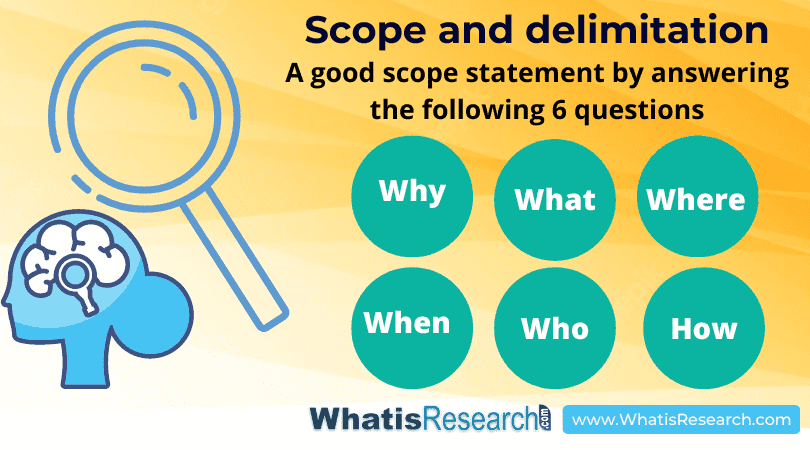
Why – the broad goals and purposes (purpose) of the study.
What – the topic under investigation and the variables used.
Where – the study’s context or location, that is, where the data will be collected and to what entity they will belong.
When – the time period during which the data must be gathered.
Who – the topic of the investigation and the demographic from whom they will be chosen. For generalizations to be possible, this population must be sizable.
How – how the research will be carried out, including the methodology, research tools, and analysis procedures. The research design, such as whether it is experimental, qualitative, or a case study, will also be described.
Here are some of the effective ways to start writing your scope:
- This study aims to…
- This study is to focus on…
- This study covers the..
Readers should understand why the delimitation criteria were chosen, what alternatives existed, and why these alternatives were rejected because the researcher had influence over these factors. The reader must comprehend how and why you choose the experiment you have if, for instance, you are gathering data that can be drawn from three distinct but comparable studies.
Here are some of the effective ways effective way to start writing your study delimitations:
- This study does not cover…
- This study is limited to…
- The following has been excluded from this study…
Must read: 7 things you must know about manuscript editing services
Scope and delimitation example
To understand better let us see the example
Let’s say one researcher wants to study the impact of using social media during working hours. In this case, it is not possible for the researcher to cover every aspect of the topic.
Therefore, the target population will need to be isolated within the scope. In this instance, the focus could be limited to a group of 100 employees in the Finance department at a single company. The impact could be observed for a duration of 6 months. These would form the delimitations of the study.
In this example, the researcher might answer why he/she chooses to study sample employees of 10. Why does he/she select the employees from the finance department, not from the HR or IT department? Why did he/she choose the XYZ Ltd company over others?
What is the purpose of scope and delimitation in research?
Scope and delimitation of the study are two important elements of a research paper that inform the reader what information is included in the research and explain why the author chose that information.
If you are about to write a research paper then one of the first tasks you need to perform when completing research is to identify the scope of the project. When identifying the scope, you need to address not only the problem or issue that you want to study but the population that you want to examine.
A delimitation is sometimes called a “ boundary condition ,” which specifies a region beyond which a theory or hypothesis is either changed or does not hold.

Final words
Both Scope and delimitation are equally important while writing your research paper or thesis. This provides a better understanding to the readers and future researchers. After reading this article Scope and delimitation. All things you need to know we hope you have a better understanding.
Find more research news on https://www.whatisresearch.com/category/latest-research-news/

Related Posts

How to find academic conferences

Wishes you a Merry Christmas 2020

How to search Scopus indexed journals
- Translators
- Graphic Designers
Please enter the email address you used for your account. Your sign in information will be sent to your email address after it has been verified.
Exploring Scope and Delimitation in Academic Research

Academic research is a meticulous process that requires precise planning and clear boundaries. Two pivotal components in this process are the scope and delimitations of the study. The definitions and establishment of these parameters are instrumental in ensuring that the research is effective, manageable, and yields relevant results.
The "scope" of a research project refers to the areas that the study will cover. It is the breadth and depth of the investigation. It defines the subject matter, the geographical location, the time frame, and the issues that the study will explore. Essentially, the scope delineates what the researcher aims to cover in the study.
On the other hand, "delimitations" are the boundaries or limitations set by the researcher. They define what the study will not include. Delimitations could involve the choice of research methodology , the selection of respondents, the duration of the study, and more. They help in confining the study to a manageable size while excluding peripheral elements.
Understanding and correctly implementing scope and delimitations are vital to ensuring your research is well-defined and focused, facilitating higher accuracy and relevancy in your findings.
Importance of scope in research
"Scope" in research refers to the comprehensive extent of study—it outlines the parameters of what will be explored and addressed. It defines the topic of the research , the geographical region under study, the timeframe considered, and the issues that the study will address. The scope of a research project is vital because it determines the depth and breadth of your investigation.
Defining the scope of research is a fundamental step in the research process for several reasons. First, it provides a roadmap for the study, giving the researcher clear guidelines about what to include and exclude. Without a well-defined scope, research can become unmanageably vast or lose its focus.
Second, the scope ensures the research's relevance and applicability. It helps the researcher maintain a tight focus on the study's central question , ensuring that all aspects of the research contribute to answering this question. This focus aids in avoiding irrelevant diversions that could dilute the final conclusions.
Finally, a well-defined scope can help ensure the efficient use of resources. Research involves considerable time, effort, and often financial resources. By providing clear boundaries, the scope ensures these resources are utilized effectively without wasted effort on peripheral issues.
Suppose a research study is looking at the impacts of social media usage on mental health. If the scope is too broad—like examining all social media platforms' effects on all demographic groups worldwide—then the research can quickly become unwieldy and hard to manage. It would involve vast amounts of data, requiring considerable time, resources, and computational power to analyze effectively.
However, if the scope is narrowed down—such as investigating the impact of Instagram usage on the mental health of teenagers in a specific city over the past five years—the research becomes far more manageable. This specific focus allows for a more in-depth analysis and likely will provide more meaningful, actionable results. This example illustrates the importance of appropriately defining the scope of research for its successful execution.
Determining the scope of your research
Setting the scope of your research project is a critical and delicate task. Below are steps, tips, and common mistakes to avoid when determining the scope of your research:
Steps to define the scope
- Identify Your Topic: The first step involves identifying and understanding your research topic. This knowledge will serve as a basis for determining the breadth and depth of your study.
- Define Your Research Questions: The research questions are the heart of your study. They will help you determine the specific areas your research should cover.
- Establish Boundaries: Clearly establish the geographical, temporal, and topical boundaries of your research. These boundaries will guide the range of your study.
- Choose Your Methodology: Decide on the research methods you will use as these will directly impact the scope of your study.
Tips for a manageable scope
- Stay Focused: Stay concentrated on your research questions. Do not stray into areas that aren't directly relevant.
- Be Realistic: Consider the resources (time, money, manpower) available. Ensure your scope is feasible given these resources.
- Seek Guidance: Consult with your academic advisor or peers for feedback on your proposed scope.
Common mistakes to avoid
- Overly Broad Scope: Avoid setting an overly broad scope which could result in an unmanageable and unfocused study.
- Too Narrow Scope: Conversely, a scope that is too narrow may miss important aspects of the research topic.
- Ignoring Resources: Not taking into account available resources when setting the scope can lead to a project that is impossible to complete.
Defining the scope of your research is a delicate balance, requiring careful consideration of your research questions, resources, and the depth and breadth of investigation needed to answer these questions effectively.
Importance of delimitations in research
In the context of academic research, "delimitations" refers to the choices made by the researcher which define the boundaries of the study. These are the variables that lead the researcher to narrow the scope of the study from its potential vastness to a manageable size.
Delimitations might include the geographic area where the study is confined, the participants involved in the study, the methodology used, the time period considered, or the specific incidents or aspects the study will focus on. Essentially, delimitations are the self-imposed limitations on the scope of the study.
Defining the delimitations of a research project is crucial for several reasons. Firstly, they establish the context or setting in which the study occurs. This, in turn, allows for the work to be reproduced in a similar context for verification or refutation in future studies.
Secondly, delimitations provide a way to narrow the scope of the research to a manageable size, thus avoiding the pitfall of an overly ambitious project. They help researchers to stay focused on the main research questions and prevent diversion into irrelevant aspects.
Finally, clearly defined delimitations enhance the credibility of the research. They offer transparency about the research design and methodology, which adds to the validity of the results.
For instance, in a research study examining the impact of technology on student achievement in a certain district, examples of delimitations might include focusing only on public schools, considering only high school students, and confining the study to a particular school year. These choices help to focus the research and ensure its manageability. Therefore, delimitations play a pivotal role in structuring and guiding an effective and efficient research study.
Setting delimitations for your research
Establishing appropriate delimitations for your research project is an important part of research design. Here are some steps, guidelines, and common mistakes to consider when setting your research delimitations:
Steps to establish delimitations
- Identify the boundaries: Begin by deciding the geographical region, time period, and subject matter your research will cover.
- Determine Your Research Population: Identify the specific population your study will focus on. This could be based on age, profession, geographical location, etc.
- Choose Your Research Methods: Decide the specific methods you will use to collect and analyze data, as these decisions will also set limitations on your study.
Guidelines for choosing delimitations
- Align with Your Research Objectives: The delimitations should be in line with your research questions and objectives. They should help focus your study without detracting from its goals.
- Be Practical: Consider the resources available, including time, funds, and access to data. Your delimitations should be feasible given these constraints.
- Seek Input: Consult with your research advisor or peers. Their feedback can help ensure your delimitations are appropriate and well thought out.
Common errors to avoid:
- Unrealistic Delimitations: Be wary of setting delimitations that are too stringent or ambitious to be feasible given your resources and timeframe.
- Undefined Delimitations: Avoid leaving your delimitations vague or undefined. This can lead to scope creep, where your project expands beyond its initial plan, making it unmanageable.
- Ignoring Delimitations: Once set, stick to your delimitations. Deviating from them can lead to a loss of focus and can compromise the integrity of your results.
Setting delimitations is a crucial step in research planning. Properly defined delimitations can make your research project more manageable, maintain your focus, and ensure the effective use of your resources.
The interplay between scope and delimitations
The relationship between scope and delimitations in academic research is a dynamic and interdependent one. Each aspect serves to shape and refine the other, ultimately leading to a focused, feasible, and effective research design.
The scope of a research project describes the breadth and depth of the investigation—what it aims to cover and how far it intends to delve into the subject matter. The delimitations, on the other hand, identify the boundaries and constraints of the study—what it will not cover.
As such, the scope and delimitations of a research study are intimately connected. When the scope of a study is broad, the delimitations must be carefully considered to ensure the project remains manageable and focused. Conversely, when the scope is narrow, the delimitations might be less constraining, but they still play a critical role in defining the specificity of the research.
Balancing the scope and delimitations is crucial for an efficient research design. Too broad a scope without carefully defined delimitations can lead to a study that is unwieldy and lacks depth. On the other hand, a very narrow scope with overly rigid delimitations might result in a study that overlooks important aspects of the research topic.
Thus, researchers must strive to maintain a balance—establishing a scope that is wide enough to fully explore the research topic, but also setting appropriate delimitations to ensure the study remains feasible and focused. In doing so, the research will be well-structured and yield meaningful, relevant findings.
Role of scope and delimitations in research validity
Scope and delimitations are fundamental aspects of research design that directly influence the validity, reliability, and replicability of a study.
Research validity refers to the degree to which a study accurately reflects or measures the concept that the researcher intends to investigate. A well-defined scope is critical to research validity because it clearly delineates what the study will cover. This clear definition ensures that the research focuses on relevant aspects of the topic and that the findings accurately reflect the concept under investigation.
Similarly, carefully thought-out delimitations contribute to research validity by identifying what the study will not cover. This clarity helps to prevent the study from straying into irrelevant areas, ensuring that the research stays focused and relevant.
In addition to contributing to research validity, scope and delimitations also influence the reliability and replicability of a study. Reliability refers to the consistency of a study's results, while replicability refers to the ability of other researchers to repeat the study and obtain similar results.
A clearly defined scope makes a study more reliable by providing a detailed outline of the areas covered by the research. This clarity makes it more likely that the study will produce consistent results. Moreover, clearly defined delimitations enhance the replicability of a study by providing explicit boundaries for the research, which makes it easier for other researchers to repeat the study in a similar context.
In summary, a well-defined scope and carefully thought-out delimitations contribute significantly to the validity, reliability, and replicability of academic research. They ensure that the research is focused, that the findings are relevant and accurate, and that the study can be reliably repeated by other researchers.
Examples of scope and delimitation in well-known research
- The Milgram Experiment: Stanley Milgram's famous psychology experiment sought to understand obedience to authority figures. The scope of this study was clearly defined—it focused on how far individuals would go in obeying an instruction if it involved harming another person. However, delimitations were set to ensure manageability. Participants were delimited to male individuals, and the experiment was confined to a controlled laboratory setting. These delimitations allowed Milgram to manage the research effectively while maintaining the depth of his study on human behavior.
- The Framingham Heart Study: This ongoing cardiovascular study began in 1948 and is aimed at identifying common factors that contribute to cardiovascular disease. The scope of the research is broad, covering many aspects of lifestyle, medical history, and physical characteristics. However, the study set clear delimitations: it initially only involved adult residents of Framingham, Massachusetts. This geographical delimitation made this broad-scope study manageable and eventually yielded influential results that shaped our understanding of heart disease.
- The Marshmallow Test: This well-known study by Walter Mischel explored delayed gratification in children. The scope was clearly defined: the study aimed to understand the ability of children to delay gratification and how it related to future success. The delimitations of the study included the age of the participants (preschool children), the setting (a controlled experiment with a treat), and the measure of future success (academic achievement, ability to cope with stress, etc.). These delimitations helped keep the study focused and manageable.
In all these examples, the researchers set a clear scope to outline the focus of their studies and used delimitations to restrict the boundaries. This balance between scope and delimitation was key in conducting successful and influential research.
In academic research, defining the scope and delimitations is a pivotal step in designing a robust and effective study. The scope outlines the breadth and depth of the investigation, offering a clear direction for the research. Meanwhile, delimitations set the boundaries of the study, ensuring that the research remains focused and manageable. Together, they play a crucial role in enhancing the validity, reliability, and replicability of a study.
Understanding the interplay between scope and delimitations is key to conducting efficient research. A well-defined scope paired with thoughtfully set delimitations contribute to a study's feasibility and its potential to yield meaningful and applicable results. Mistakes in setting the scope and delimitations can lead to unwieldy, unfocused research or a study that overlooks important aspects of a research question.
Reviewing famous studies, like the Milgram Experiment, the Framingham Heart Study, and the Marshmallow Test, we observe how a balanced approach to setting scope and delimitations can result in influential and valuable findings. Therefore, researchers should give careful thought to defining the scope and delimitations of their studies, keeping in mind their research questions, available resources, and the need for balance between breadth and focus. By doing so, they pave the way for successful and impactful research outcomes.
Header image by Kübra Arslaner .

Stating the Obvious: Writing Assumptions, Limitations, and Delimitations

During the process of writing your thesis or dissertation, you might suddenly realize that your research has inherent flaws. Don’t worry! Virtually all projects contain restrictions to your research. However, being able to recognize and accurately describe these problems is the difference between a true researcher and a grade-school kid with a science-fair project. Concerns with truthful responding, access to participants, and survey instruments are just a few of examples of restrictions on your research. In the following sections, the differences among delimitations, limitations, and assumptions of a dissertation will be clarified.
Delimitations
Delimitations are the definitions you set as the boundaries of your own thesis or dissertation, so delimitations are in your control. Delimitations are set so that your goals do not become impossibly large to complete. Examples of delimitations include objectives, research questions, variables, theoretical objectives that you have adopted, and populations chosen as targets to study. When you are stating your delimitations, clearly inform readers why you chose this course of study. The answer might simply be that you were curious about the topic and/or wanted to improve standards of a professional field by revealing certain findings. In any case, you should clearly list the other options available and the reasons why you did not choose these options immediately after you list your delimitations. You might have avoided these options for reasons of practicality, interest, or relativity to the study at hand. For example, you might have only studied Hispanic mothers because they have the highest rate of obese babies. Delimitations are often strongly related to your theory and research questions. If you were researching whether there are different parenting styles between unmarried Asian, Caucasian, African American, and Hispanic women, then a delimitation of your study would be the inclusion of only participants with those demographics and the exclusion of participants from other demographics such as men, married women, and all other ethnicities of single women (inclusion and exclusion criteria). A further delimitation might be that you only included closed-ended Likert scale responses in the survey, rather than including additional open-ended responses, which might make some people more willing to take and complete your survey. Remember that delimitations are not good or bad. They are simply a detailed description of the scope of interest for your study as it relates to the research design. Don’t forget to describe the philosophical framework you used throughout your study, which also delimits your study.
Limitations
Limitations of a dissertation are potential weaknesses in your study that are mostly out of your control, given limited funding, choice of research design, statistical model constraints, or other factors. In addition, a limitation is a restriction on your study that cannot be reasonably dismissed and can affect your design and results. Do not worry about limitations because limitations affect virtually all research projects, as well as most things in life. Even when you are going to your favorite restaurant, you are limited by the menu choices. If you went to a restaurant that had a menu that you were craving, you might not receive the service, price, or location that makes you enjoy your favorite restaurant. If you studied participants’ responses to a survey, you might be limited in your abilities to gain the exact type or geographic scope of participants you wanted. The people whom you managed to get to take your survey may not truly be a random sample, which is also a limitation. If you used a common test for data findings, your results are limited by the reliability of the test. If your study was limited to a certain amount of time, your results are affected by the operations of society during that time period (e.g., economy, social trends). It is important for you to remember that limitations of a dissertation are often not something that can be solved by the researcher. Also, remember that whatever limits you also limits other researchers, whether they are the largest medical research companies or consumer habits corporations. Certain kinds of limitations are often associated with the analytical approach you take in your research, too. For example, some qualitative methods like heuristics or phenomenology do not lend themselves well to replicability. Also, most of the commonly used quantitative statistical models can only determine correlation, but not causation.
Assumptions
Assumptions are things that are accepted as true, or at least plausible, by researchers and peers who will read your dissertation or thesis. In other words, any scholar reading your paper will assume that certain aspects of your study is true given your population, statistical test, research design, or other delimitations. For example, if you tell your friend that your favorite restaurant is an Italian place, your friend will assume that you don’t go there for the sushi. It’s assumed that you go there to eat Italian food. Because most assumptions are not discussed in-text, assumptions that are discussed in-text are discussed in the context of the limitations of your study, which is typically in the discussion section. This is important, because both assumptions and limitations affect the inferences you can draw from your study. One of the more common assumptions made in survey research is the assumption of honesty and truthful responses. However, for certain sensitive questions this assumption may be more difficult to accept, in which case it would be described as a limitation of the study. For example, asking people to report their criminal behavior in a survey may not be as reliable as asking people to report their eating habits. It is important to remember that your limitations and assumptions should not contradict one another. For instance, if you state that generalizability is a limitation of your study given that your sample was limited to one city in the United States, then you should not claim generalizability to the United States population as an assumption of your study. Statistical models in quantitative research designs are accompanied with assumptions as well, some more strict than others. These assumptions generally refer to the characteristics of the data, such as distributions, correlational trends, and variable type, just to name a few. Violating these assumptions can lead to drastically invalid results, though this often depends on sample size and other considerations.
Click here to cancel reply.
You must be logged in to post a comment.
Copyright © 2024 PhDStudent.com. All rights reserved. Designed by Divergent Web Solutions, LLC .

IMAGES
VIDEO
COMMENTS
Delimitations refer to the specific boundaries or limitations that are set in a research study in order to narrow its scope and focus. Delimitations may be related to a variety of factors, including the population being studied, the geographical location, the time period, the research design, and the methods or tools being used to collect data.
Scope of research refers to the range of topics, areas, and subjects that a research project intends to cover. It is the extent and limitations of the study, defining what is included and excluded in the research. The scope of a research project depends on various factors, such as the research questions, objectives, methodology, and available ...
This portion tells two things: 1. The study's "Scope" - concepts and variables you have explored in your research and; The study's "Delimitation" - the "boundaries" of your study's scope. It sets apart the things included in your analysis from those excluded. For example, your scope might be the effectiveness of plant ...
The scope and delimitations of a thesis, dissertation or research paper define the topic and boundaries of the research problem to be investigated. The scope details how in-depth your study is to explore the research question and the parameters in which it will operate in relation to the population and timeframe.
Your study's scope and delimitations are the sections where you define the broader parameters and boundaries of your research. The scope details what your study will explore, such as the target population, extent, or study duration. Delimitations are factors and variables not included in the study. Scope and delimitations are not methodological ...
The scope and delimitations of a study are foundational elements that guide the research process, setting clear boundaries and focusing efforts. By defining these aspects clearly, researchers can provide a clear roadmap for their investigation, ensuring that their work is both manageable and relevant. By consciously deciding what to exclude ...
In simpler words, scope is the breadth of your study, while delimitation is the depth of your study. Scope and delimitation are both essential components of a research project, and they are often confused with one another. The scope defines the parameters of the study, while delimitation sets the boundaries within those parameters.
Step-by-Step Guide to Writing a Research Scope. 1. Identify Your Research Problem. Start by narrowing down your broad research area to a specific problem. This helps define the purpose of your study and guides the rest of your scope. For example, instead of studying "The effects of social media," you might explore "The impact of Instagram ...
What is scope and delimitation in research. The scope of a research paper explains the context and framework for the study, outlines the extent, variables, or dimensions that will be investigated, and provides details of the parameters within which the study is conducted.Delimitations in research, on the other hand, refer to the limitations imposed on the study.
Research Delimitations. Alright, now that we've unpacked the limitations, let's move on to the delimitations.. Research delimitations are similar to limitations in that they also "limit" the study, but their focus is entirely different.Specifically, the delimitations of a study refer to the scope of the research aims and research questions.In other words, delimitations reflect the ...
Scope and Delimitation. Scope and delimitation are crucial components of a research project, outlining its boundaries and specifying what is included and excluded. The scope details the extent of the study, including its aims, geographical area, time frame, and subjects involved. Delimitations, on the other hand, define the parameters set by ...
Guidelines on writing scope and delimitation of the study Discover some recommendations about correctly completing these sections of your academic papers. ... Understanding and setting the scope and research delimitations are fundamental to ensuring its success. These elements help maintain the focus and manageability of the project, providing ...
The scope of your project sets clear parameters for your research. A scope statement will give basic information about the depth and breadth of the project. It tells your reader exactly what you want to find out, how you will conduct your study, the reports and deliverables that will be part of the outcome of the study, and the responsibilities ...
In order to write the scope of the study that you plan to perform, you must be clear on the research parameters that you will and won't consider. These parameters usually consist of the sample size, the duration, inclusion and exclusion criteria, the methodology and any geographical or monetary constraints. Each of these parameters will have ...
Additional examples of limitations are a lack of previous research on the subject to analyze and work from, a lack of access to the right tools and technology to collect data, and a lack of financial resources to sustain the research. Unlike researcher-defined delimitations, these limitations are initially unforeseen and outside of the ...
To define your scope of research, consider the following: Budget constraints or any specifics of grant funding. Your proposed timeline and duration. Specifics about your population of study, your proposed sample size, and the research methodology you'll pursue. Any inclusion and exclusion criteria. Any anticipated control, extraneous, or ...
Scope and delimitation are the two vital things in any research paper and thesis. The scope of a study describes how deeply the research area will be investigated in the work and establishes the limitations that the investigation will operate. Delimitations are the parameters set by the researcher to determine what to include and what to leave ...
This video contains a comprehensive discussion about the scope and delimitations of a research study. It also provides guidelines and some tips on how to wri...
The delimitations of a study are those characteristics that arise from limitations in the scope of the study (defining the boundaries) and by the conscious exclusionary and inclusionary decisions made during the development of the study plan. Unlike limitations, which flow from implicit characteristics of method and design, delimitations
Conclusion. In academic research, defining the scope and delimitations is a pivotal step in designing a robust and effective study. The scope outlines the breadth and depth of the investigation, offering a clear direction for the research. Meanwhile, delimitations set the boundaries of the study, ensuring that the research remains focused and ...
Delimitations are the definitions you set as the boundaries of your own thesis or dissertation, so delimitations are in your control. Delimitations are set so that your goals do not become impossibly large to complete. Examples of delimitations include objectives, research questions, variables, theoretical objectives that you have adopted, and ...
1 Answer to this question. Answer: The scope of a study is the extent to which you will examine the topic of your study. It is often necessary to restrict the scope of your study, otherwise, the study will become unfeasible, whether in terms of time, budget, or participants. Delimitations are the constraints a researcher places on a study for ...
Answer: Scope and delimitations are two elements of a research paper or thesis. The scope of a study explains the extent to which the research area will be explored in the work and specifies the parameters within which the study will be operating. For example, let's say a researcher wants to study the impact of mobile phones on behavior ...